

How to Describe a Sunset in Writing: 100 Best Words & Phrases
The dazzling spectacle of a sunset is a feast for the senses. Capturing this phenomenon in words, however, can feel impossible.
Here’s how to describe a sunset in writing:
Describe a sunset in writing by using vivid words like “radiant” and “luminous,” phrases like “a dance of light before evening,” metaphors like “the sunset was a pyre,” and carefully crafted descriptions that reflect character emotions, moods, or circumstances. Avoid cliches and over description.
In this guide, you’ll learn everything you need to know about how to describe a sunset in writing.
Words to Describe a Sunset

Table of Contents
Descriptive words are the building blocks of compelling narratives.
Here are illustrative terms to breathe life into your sunset depictions:
- Kaleidoscopic – Perfect for describing the changing pattern of colors.
- Luminous – To express the radiant light emitted by the setting sun.
- Crimson – To depict the deep, rich red color in the sunset sky.
- Glowing – Ideal for the warm radiance that engulfs the sky.
- Hazy – Useful for slight obscurity or softness to the sunset.
- Dusky – Describes the darker phase of sunset or twilight.
- Silhouetted – To depict objects as dark shapes against the bright sunset sky.
- Molten – To suggest the sky melting into stunning warm hues.
- Smoldering – For a sunset that seems to burn with low or suppressed light.
- Twilight – The period of diminished light after the sun has set.
- Amber – Describes the beautiful orange-yellow hue often seen at sunset.
- Radiant – Expresses a brilliant, glowing sunset.
- Translucent – For describing the effect of light filtering through the clouds.
- Pastel – Can depict softer, lighter colors in the sky.
- Vibrant – For describing a bright, intense sunset.
- Iridescent: Suggesting a display of lustrous, changing colors.
- Dappled: To describe light with spots or patches of color.
- Opalescent: Useful when the sunset colors shine and change color like an opal.
- Inky: Depicting deep, dark blues of a late sunset.
- Pearlescent: For a soft, glowing light with a slightly pinkish hue.
- Ethereal: To illustrate a sunset that is delicately beautiful.
- Gilded: Ideal for describing a scene touched with golden light.
- Velvety: To describe the soft, soothing colors of the twilight sky.
- Incandescent: To portray intense, bright light.
- Misty: Useful when a fine spray or light fog mutes the sunset’s glow.
- Resplendent: To depict a brilliantly shining sunset.
- Fiery: Perfect for illustrating a bold, bright, burning sunset.
- Azure: Describes the rich, blue sky against a setting sun.
- Fading: To express the gradual disappearance of sunlight.
- Majestic: For portraying a sunset of grandeur and beauty.
Phrases to Describe a Sunset
Phrases can encapsulate the atmosphere and allure of a sunset. Here are 15 expressions to embody the sunset’s charm:
- A cascade of colors showering the sky
- The sun bidding adieu to the day
- A symphony of hues painting the evening
- The sky set ablaze in the evening’s grandeur
- A mosaic of fiery oranges and purples
- Shadows creeping in as daylight recedes
- A melting pot of golds and reds
- The day dissolving into a soft, dreamy twilight
- The horizon set on fire by the departing sun
- A pastel wash over the canvas of the sky
- The sun descending into a sea of gold
- A display of colors dancing across the celestial stage
- The evening donned its twilight robe
- The dying day whispering its goodbye in hues of red
- The sunset, a beacon guiding the night
- The sky, a spill of molten gold
- A dance of light before the evening’s curtain call
- A canvas brushed with fiery strokes
- Colors woven into the day’s farewell song
- The sun melting into the horizon’s embrace
- Shadows lengthening beneath the twilight’s glow
- Daylight’s last sigh setting the sky aflame
- A riot of colors saluting the departing sun
- The sun, swallowed by the thirsty horizon
- A spectacle of hues melting into dusk
- The sunset weaving a tapestry of twilight
- Colors bleeding into the dusk’s blank canvas
- The sunset spilling its radiant potion into the evening
- Day’s candle snuffed out by the twilight
- The sunset, an ethereal lullaby coaxing the day to sleep
Metaphors to Describe Sunsets
Metaphors allow a creative approach to describing a sunset.
Here are metaphors to inspire you:
- The sunset was an artist’s palette, spattered with brilliant hues.
- The sun, like a golden disc, slipped beneath the ocean’s edge.
- Twilight arrived, draping a velvet blanket over the city.
- The sunset was a symphony, each color a note blending into the next.
- The evening was a slowly burning ember, glowing with the day’s end.
- The sky was an ever-changing canvas, the sun its passionate artist.
- The setting sun was a jewel sinking into the treasury of the night.
- The sunset was a poem written in vibrant colors across the sky.
- The dying sun bled its light onto the horizon.
- The evening sky was a stained glass window, ablaze with the setting sun’s brilliance.
- The sunset was a magician, transforming the day into a spectacle of color.
- The sun dipped into the horizon like a coin into a wishing well.
- The sky, an artist, blended the sunset hues like watercolors.
- The sunset, a glowing lantern, guided the night sky.
- The day folded into the sunset like a beautiful end to a tale.
- The sunset was a tangerine dream, sprinkled with hues of passion.
- The sun, like a stage actor, took a bow before the curtains of night drew close.
- The twilight wore a cloak woven with the day’s last light.
- The sunset was a lullaby, soothing the day into a peaceful slumber.
- The setting sun was a silent storyteller, whispering tales in vibrant colors.
- The sky was a canvas, the sun a master painter wielding a brush of light.
- The sunset was a pyre, ablaze with the day’s final memories.
- The day folded into the colors of the sunset, like a poem coming to a quiet end.
- The sun dipped into the ocean, leaving behind a pool of gold.
- The twilight was a veil, embroidered with the sunset’s farewell kiss.
- The sunset was a serenade, its colors dancing to the rhythm of goodbye.
- The setting sun was a ship, sinking beneath the ocean of the night.
- The dying day was a phoenix, ablaze with beauty before its fall.
- The sun was a master puppeteer, pulling at the strings of twilight.
- The sunset was a sonnet, each color a word in its sweet, fleeting verse.
Here is a good video about how to describe a sunset in writing:
Describing Sunsets in Different Moods, Genres, and Fictional Scenes
Capturing the essence of a sunset can vary greatly depending on the context of the scene.
Here are some examples of how to describe sunsets in different moods, genres, and fictional scenes:
Romantic Mood
As the day whispered its goodbye, the sky erupted into a kaleidoscope of pastel hues. The sun, a molten orange sphere, dipped slowly, casting long shadows that danced with the fading day. Their silhouettes, locked in an embrace, were painted against the radiant canvas of the twilight, capturing a moment as tender and transient as the setting sun.
Action Scene
Above the clash of swords and the screams of combat, the sun bled crimson against the turbulent sky. It was a smoldering ember, matching the fire in the warriors’ hearts as they fought beneath the dusky canvas. The battlefield was ablaze, not just with the wrath of men, but with the glow of a day meeting its violent end.
Sci-Fi Genre
Against the alien skyline, the twin suns sank in a symphony of radiant colors. Hues unknown to earthly eyes danced across the atmospheric layers, creating an ethereal twilight. The celestial bodies, two luminous discs, descended into the horizon, signaling the arrival of the planet’s nocturnal phase.
Horror Genre
As the sun receded, a hazy gloom started to shroud the abandoned mansion. The sunset, usually vibrant and inviting, seemed ominous with its crimson and amber streaks slashing the sky. Shadows began to creep, their dark tendrils twining with the twilight, creating an eerie silhouette of the once grand edifice.
Mystery Genre
As the day drew to its clandestine close, the sun draped the city in an inky veil, tucking away secrets beneath the cloak of twilight. The sky, now an opalescent sea, seemed to hold whispers of forgotten tales, its ethereal glow a silent testament to the city’s unsolved mysteries.
Adventure Scene
Against the backdrop of uncharted terrains, the sunset unfurled like a resplendent banner, marking the end of their day’s journey. Fiery streaks of red and orange blazed across the horizon, a wild, untamed beauty that mirrored their own relentless spirit.
Historical Fiction
As the cannons fell silent, the sun set on the battlefield, cloaking it with a somber twilight. The fading light, a soft tapestry of purples and blues, seemed to mourn the day’s losses. Even in the throes of defeat, there was a majestic, if somber, beauty to the sunset.
Psychological Thriller
As the sun slithered beneath the horizon, the shadows seemed to lengthen, their inky tendrils reaching out to claim the city. The sunset was not a gentle fading of light but a swift, merciless plunge into the unknown. It was a time of transition, a time when illusions could become realities.
How to Describe How a Sunset Makes a Character Feel
A sunset can evoke a myriad of emotions in a character.
By describing these feelings, you can deepen character development and enhance your narrative’s emotive impact.
Here are a few ways to depict how a sunset might affect your character’s emotions:
Reflective Mood
As he watched the sun dip beneath the horizon, a wave of nostalgia washed over him. The melting pot of golds and reds was reminiscent of the past, each fading ray a fleeting memory, whispering tales of days long gone. The tranquility of the dusk lent itself to reflection, the twilight sky becoming a mirror to his thoughts.
Joyful Mood
The sight of the setting sun filled her heart with an indescribable joy. It was as if the sky was painting her happiness, the vibrant colors dancing in tune with her elated heartbeat. Each hue was a symphony of delight, their radiant symphony echoing her inner euphoria.
His heart fluttered as he took in the sunset, its kaleidoscopic colors reflecting the warmth spreading through his veins. The setting sun, with its passionate display, seemed to mirror his growing feelings for her. The twilight held a romantic allure, the descending darkness promising whispers of love .
Melancholy Mood
She stared into the descending sun, its fading light a mirror to her desolation. The sunset was a silent symphony of blues, its melancholic tune resonating with her lonely heart. The encroaching twilight felt heavy, each shadow echoing her sorrow.
Hopeful Mood
Watching the sun set, he felt a surge of hope. The beautiful transition from day to night served as a reminder that endings could be stunning too. Each streak of color was a promise, a symbol of potential hiding in the wait for a new dawn. Despite the descending darkness, the sunset instilled in him a radiant optimism.
By aligning a character’s emotions with the descriptive imagery of a sunset, you can create powerful, emotive scenes that stay with your reader long after they’ve finished the page.
How to Describe the Colors of a Sunset
A sunset offers a magnificent play of colors that can be used to create vivid, picturesque imagery in your narrative.
Describing these colors can set the mood, enhance the scenery, and evoke emotions.
Here are a few ways to describe the colors of a sunset:
Reds and Oranges
The sunset painted the sky with a wash of crimson and amber. It was as if an unseen artist had dipped their brush in fire and swept it across the canvas of the sky, creating a blazing spectacle that took one’s breath away. The reds and oranges fused, a fiery symphony bidding farewell to the day.
Pinks and Purples
As the sun descended, the evening sky blushed in hues of pink and purple. The delicate colors swirled together, creating a twilight tapestry that held the soft allure of a summer dream. The pinks bled into purples, their dance reminiscent of a blossoming romance between the day and the night.
Blues and Greys
The sky darkened, the once vibrant palette of the sunset fading into shades of blue and grey. The transformation was subtly beautiful, like the closing lines of a melancholic poem. The blues deepened into greys, their somber elegance serving as a serene prelude to the nocturnal symphony.
Golds and Yellows
The sunset bathed the horizon in shades of gold and yellow. It was as if the sun had melted into a pool of liquid light, its radiant essence seeping into the corners of the evening. The golden hues danced on the water’s surface, turning the lake into a shimmering mirror reflecting the day’s grand finale.
As the sun kissed the day goodbye, it set the sky alight with a riot of colors. Reds, oranges, pinks, and purples melded together in a spectacular kaleidoscope, their dazzling display creating a vibrant spectacle. It was a chromatic symphony, a feast for the eyes, each color a beautiful note in the sunset’s captivating melody.
Biggest Mistakes Writers Make When Describing a Sunset
Avoid these common pitfalls when describing a sunset to enrich your narrative:
- Over-description – Too much detail can lose the reader’s attention. Aim to evoke feelings and moods instead of meticulously describing every shade.
- Clichés – Overused phrases can bore readers. Use fresh, unique descriptions to captivate your audience.
- Ignoring the senses – Incorporate the sound, feel, and even smell of the surroundings to provide a holistic picture.
- Lack of context – Make sure the sunset description fits the context and tone of your story or text. A sunset description may not fit a tense or action-packed scene.
- Ignoring the character’s perspective – Remember, different characters might perceive the same sunset differently based on their personalities and emotions.
- Overuse of adjectives – While adjectives can be powerful, over-relying on them can make your writing feel less genuine and impactful.
- Failing to match the sunset with the story’s mood – A beautifully described sunset can feel jarring in a tense or dramatic scene. Match the description to the tone of the scene for best effect.
Final Thoughts: How to Describe a Sunset in Writing
Just like a true sunset, each description is unique and transient, carrying the essence of the moment within its wavering lines.
Harness the full spectrum of your linguistic palette to create sunset scenes that are as moving and memorable as the real thing.
Related posts:
- 30 Words To Use In Gothic Fiction (Gothic Word Guide)
- 55 Best Demonic Words for Fiction (Meanings & Examples)
- How To Write a Sad Scene: A Full Guide With 10 Examples
- How Can You Get Rid of Cluttered Writing? (22 Easy Ways)

Writing Nestling

How To Describe A Sunset In Writing (Words, Phrases & Metaphors)
Describing a sunset in writing is an exquisite journey into the realm of poetic expression and vivid imagery.
Sunsets, with their ever-shifting colors, dramatic silhouettes, and ephemeral beauty, offer writers a profound opportunity to capture the magic of nature’s daily spectacle and transport readers into a world of emotion, sensory immersion, and contemplation.
Through the interplay of words and the artful manipulation of literary devices, a well-crafted sunset description can evoke a symphony of feelings, leaving an indelible mark on the reader’s soul.
In the pages that follow, we will explore the intricacies of this art, from setting the scene and harnessing the power of symbolism to the delicate task of conveying the sublime.
Join us in this exploration, as we delve into the language of sunsets, and learn how to harness the written word to paint the evening sky with the brush of imagination.
Table of Contents
How To Describe A Sunset In Writing
Describing a sunset in writing involves capturing the vivid imagery and emotions associated with this natural phenomenon. Here is a step-by-step process to do so:
Observe the Sunset
Find a suitable location where you can watch the sunset. Pay close attention to the colors, shapes, and overall ambiance.
Set the Scene
Begin your description by setting the scene. Mention the location, time of day, and any notable features in the surroundings.
Color Palette
Describe the colors in the sky. Start with the warm, vibrant hues like orange, pink, and red. Mention any cool shades like purple or blue. Use vivid and expressive language to convey the richness of these colors.
Light and Shadow
Talk about how the fading sunlight creates contrasts of light and shadow. Mention how the landscape changes as the sun descends.
Clouds and Patterns
Describe the clouds, if any. Mention their shapes, sizes, and how they interact with the setting sun. This can add depth and texture to your description.
Sun’s Descent
Highlight the sun’s movement as it sinks below the horizon. Use metaphors or similes to make the process more engaging. For example, “The sun dipped like a burning ember into the sea.”
Reflections
If you’re near a body of water, note the reflections of the sunset on the surface. It adds a unique element to your description.
Explain how the atmosphere changes as the sun sets. Mention any effects like a golden glow, a dusky hue, or the emergence of stars.
Sounds and Aromas
Include any sounds or aromas associated with the sunset, like the chirping of birds, the rustling of leaves, or the scent of the evening air.
Share the emotions you experience or imagine others might feel during the sunset. It could be a sense of peace, awe, nostalgia, or even melancholy.
Personal Connection
If you have a personal connection or memory associated with the sunset, share it. This can add depth and authenticity to your description.
Flow and Imagery
Ensure your description flows smoothly. Use metaphors, similes, and descriptive language to create a vivid mental picture for your readers.
Edit and Revise
After writing your description , edit and revise it for clarity, conciseness, and impact. Make sure your words evoke the desired feelings and imagery.
Remember that your description should engage the reader’s senses and emotions, allowing them to visualize the sunset as if they were experiencing it themselves. Use your creativity to craft a compelling and evocative piece of writing .

Words To Describe A Sunset
Dusk: The time when the sun disappears below the horizon, marking the onset of evening.
Radiant: Emitting a vivid and brilliant glow, as seen during a vibrant sunset.
Crimson: A deep red color often associated with the intense hues of a sunset sky.
Serene: Calm, peaceful, and tranquil, characteristic of the atmosphere during a sunset.
Silhouette: The dark outline or shape of an object against the colorful backdrop of a setting sun.
Golden Hour: The magical period shortly before sunset when the sunlight is soft, warm, and golden.
Twilight: The transitional phase between day and night, featuring dimming light and varied hues.
Hues: The wide range of colors and shades displayed in the sky during a sunset.
Embers: Resembling the dying glow of a fire, used to depict the fading light of a setting sun.
Horizon: The apparent line where the earth and sky meet, often the focal point during sunset observations.
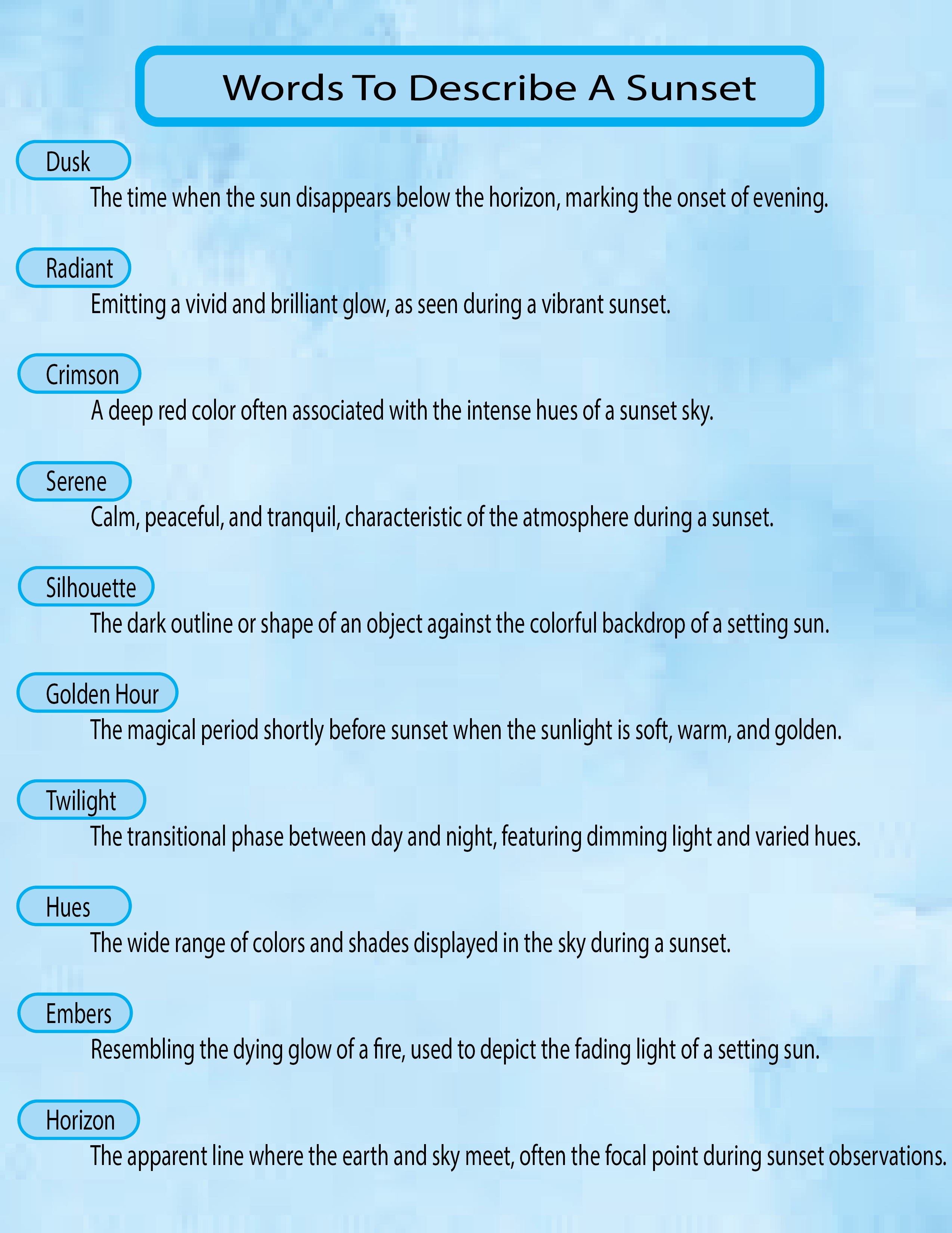
Phrases To Describe A Sunset
1. The sun dipped below the horizon, painting the sky in hues of pink and gold.
2. As daylight faded, the horizon became a canvas of fiery oranges and purples.
3. A warm glow enveloped the landscape as the sun bid farewell to the day.
4. The tranquil evening sky was adorned with the soft pastels of a setting sun.
5. A cascade of colors unfolded, casting a warm embrace over the world.
6. The sun’s descent turned the clouds into a canvas, each stroke a masterpiece.
7. The horizon became a melting pot of warm tones, creating a breathtaking spectacle.
8. As the sun kissed the day goodbye, it left behind a trail of molten gold.
9. The landscape transformed into a silhouette, the sun’s final bow before nightfall.
10. The twilight sky whispered secrets of the day’s end, wrapped in hues of serenity.
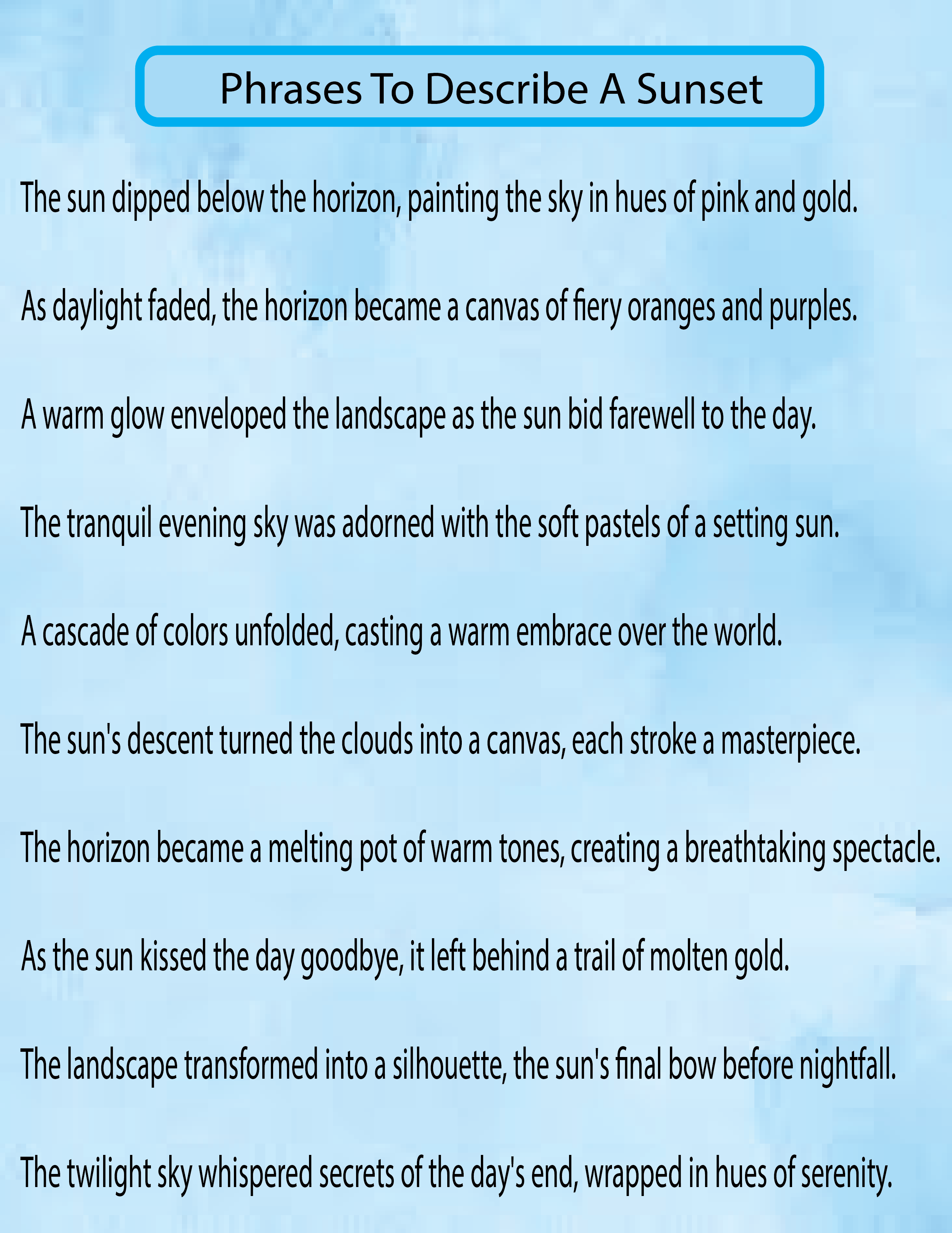
Metaphors To Describe A Sunset
The Day’s Sigh: The sunset, akin to the world taking a deep breath, exhaling the day’s warmth and light.
Dying Embers of Day: The sun, like dying embers, slowly fading and casting a warm glow across the horizon.
Heaven’s Palette: The sunset as if the heavens dipped their brushes into a palette, painting the sky with celestial hues.
Farewell Kiss of Day: The sun’s descent, a tender farewell kiss, leaving behind a blush on the horizon.
Ocean of Fire: The sky ablaze with the colors of a setting sun, resembling an ocean of flickering flames.
Setting the Scene
Setting the scene is the writer’s brushstroke on the canvas of imagination, where the world is not just a backdrop but a character in its own right.
Whether it’s the untamed beauty of a coastal sunset, the urban jungle with its skyscrapers kissed by twilight, or the quiet serenity of a rural landscape bathed in the dying embers of daylight, the setting is where the stage is meticulously crafted for the sun’s grand finale.
It’s the moment when time, place, and atmosphere unite to create a symphony of visuals that etch themselves into memory.
So, step into the scene with your readers, for in this chapter of the story, the sun and its canvas await your artistic touch.
Location is the cornerstone of any sunset’s narrative. It’s the setting’s identity, the stage upon which the sun’s fiery performance unfolds.
A coastal location evokes the rhythmic cadence of waves crashing against the shore, painting the horizon with hues of red and gold.
In the heart of an urban sprawl, skyscrapers become silhouetted sentinels, and the setting sun casts a warm glow upon the city’s concrete and glass.
Conversely, a rural location brings forth the tranquil beauty of open fields or rolling hills, where the sun’s descent is witnessed in a hushed reverence, painting the sky in pastel shades.
Each location holds its unique charm, and the choice of setting is the first brushstroke on the canvas of a sunset’s description, setting the tone for the sensory symphony to come.
Time of Year
The time of year is the conductor of the ever-changing symphony of sunsets, orchestrating different hues, moods, and emotions with each passing season.
In spring, sunsets possess a delicate and hopeful essence, painting the sky with soft pastels as nature renews itself. Summer sunsets are a blaze of fiery glory, casting a warm, nostalgic glow as the day’s heat gradually cools.
Autumn brings with it the rich, earthy colors of falling leaves, infusing sunsets with a sense of transition and introspection.
And in the midst of winter, sunsets exhibit a serene and ethereal beauty, as the world is blanketed in stillness and the sun’s descent carries a promise of rebirth.
The time of year is a crucial aspect of sunset description, adding layers of symbolism and emotion to the scene.
Weather Conditions
Weather conditions play a pivotal role in the enchanting drama of a sunset. They can transform a routine sunset into a spellbinding spectacle or shroud it in a mystique all its own.
A clear sky offers a canvas for vibrant colors and sharp details, allowing the sun to paint the horizon with precision. On the other hand, a sky filled with billowing clouds can add drama and intrigue, as the sun’s rays play hide-and-seek, casting ever-changing patterns of light and shadow.
Stormy weather may infuse a sunset with a wild, untamed energy, while a gentle, misty rain can create an atmosphere of dreamy enchantment.
Weather conditions, in their capricious dance, enhance the unpredictability and raw beauty of a sunset, making each one a unique masterpiece to be witnessed and described with wonder.
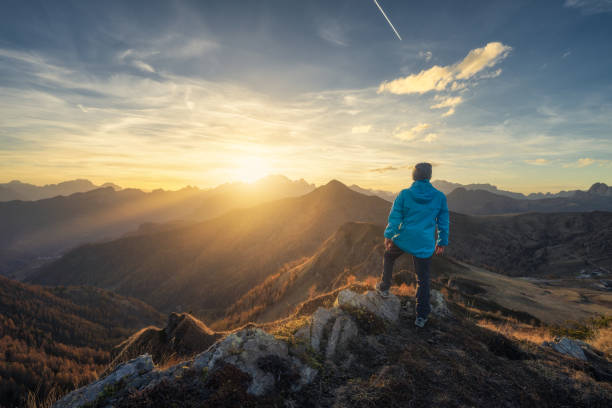
Descriptive Elements
Descriptive elements are the palette of a writer’s soul, the pigments with which they paint their sunset masterpiece.
It’s where the sky transforms into a canvas of warm, blazing oranges and deep purples, or softens into a tranquil wash of pastel pinks and lavenders.
Here, the sun takes its final bow, casting a golden glow that bathes the world in a surreal, ethereal light, as shadows stretch and merge into silhouettes.
It’s the moment when the atmosphere itself becomes an artist, with the colors and shades evolving in a dance of gradual fading and reflection.
Descriptive elements are the essential strokes that bring the scene to life, rendering the sunset in all its magnificent and ever-changing splendor, inviting the reader to step into the painting and bask in the poetry of the evening sky.
Colors in a sunset are the kaleidoscope of emotions and sensations that streak across the canvas of the sky. They are the artists’ tools that evoke the full spectrum of human feelings.
Warm, fiery reds and oranges paint the heavens with a passionate intensity, igniting the heart with the fervor of a love story . Cool, soothing purples and blues create an aura of calm and contemplation, like a lullaby for the soul.
The transition from day to night through these colors is a metamorphosis of the world itself, a visual symphony that whispers tales of beginnings and endings.
Colors in a sunset are not just pigments; they are the storytellers of the evening, unraveling narratives that captivate and embrace the reader, making them a part of this mesmerizing journey through the horizon.
Light and Shadows
Light and shadows in a sunset are the silent actors in a grand celestial drama, engaging in a dance of stark contrast and harmonious coexistence.
During the golden hour, the sun’s warm, low-angled light bathes the landscape in a soft, enchanting radiance, casting long, dramatic shadows that stretch and morph with the shifting celestial clock.
Silhouettes emerge, transforming ordinary objects into captivating outlines, and the world becomes a theater of contrasts where dark meets light.
Light and shadows together create a sense of depth and dimension, adding an ethereal quality to the scene.
The interplay of these elements captures the essence of a transient moment, where the sun gracefully bows to the impending night, leaving a trail of shadows and memories in its wake.
Atmospheric Effects
Atmospheric effects in a sunset are the subtle magicians of the sky, responsible for the mesmerizing transformations that occur as the day transitions into night.
As the sun approaches the horizon, the atmosphere undergoes a metamorphosis, scattering its light and bending it in unique ways.
This gradual fading of the sun’s brilliance allows for the emergence of a tranquil, otherworldly radiance that envelops the surroundings.
It’s a time when the sky may blush with delicate hues, and the sun’s reflection upon water or cityscapes takes on an almost mystical quality.
Atmospheric effects serve as a bridge between the mundane and the extraordinary, drawing the viewer into a reverie where time seems to momentarily stand still.
In this ephemeral interplay between light, particles, and the sky, the world becomes a canvas where dreams and reality blend, encapsulating the enchantment of the fleeting twilight hour.
Emotions and Sensations
Emotions and sensations are the soul’s response to the poetry of a sunset, a symphony of feelings conducted by the fading sun.
As the day wanes, a medley of sentiments awakens within us, from the gentle caress of nostalgia as we bid adieu to the departing sun, to the euphoric rush of witnessing nature’s breathtaking spectacle.
The fiery hues of a vibrant sunset might set our hearts ablaze with passion, while the cool, soothing tones bring a sense of serenity and introspection.
In the twilight’s embrace, we may find ourselves contemplating life’s mysteries, feeling an inexplicable connection to the cosmos.
The scent of the evening air, the gentle kiss of a breeze, and the whispers of nature become intertwined in a sensory tapestry that heightens our awareness.
Emotions and sensations transform a sunset into a personal, visceral experience, one where time seems suspended, and the world becomes a canvas upon which we paint our own feelings, adding layers of depth to the already breathtaking scene.

Personal Feelings
Personal feelings during a sunset are like a secret diary, each hue in the sky mirroring the shades of our own emotions.
The sun’s descent can invoke a profound sense of wonder, a quiet introspection, or even a melancholic nostalgia.
As we watch the sky transform, we may find our hearts echoing the transition, experiencing a symphony of emotions that range from joy to introspection, and sometimes, a hint of sadness as we bid adieu to the day.
The beauty of a sunset lies in its ability to elicit a deeply personal response, a reflection of our own inner world projected onto the canvas of the evening sky.
It’s in these moments that we find solace, inspiration, or a chance to simply be present in the world, forging a unique and intimate connection between ourselves and the natural world.
Symbolism and Imagery
Symbolism and imagery in a sunset narrative are the tools of a storyteller’s alchemy, where the ordinary sky becomes a realm of metaphors and allegories.
The setting sun can be a metaphor for the passage of time, a reminder of life’s impermanence, or a beacon of hope for new beginnings.
The image of a fiery sun sinking into the horizon can represent a passionate love affair, while the tranquil, serene colors may evoke a sense of inner peace and contentment.
The sky may become a canvas for the reader’s imagination, with clouds transformed into mythical creatures or distant lands waiting to be explored.
In a well-crafted sunset description, symbolism and imagery breathe life into the scene, inviting readers to uncover layers of meaning and emotion, making the experience not only visually stunning but intellectually and emotionally resonant.
The Narrative
The narrative of a sunset is a silent, yet profoundly eloquent, epic unfolding in the sky. It’s a story that begins with the first hints of twilight, where the sun takes its first steps towards the horizon, casting long shadows and painting the world with its warm embrace.
As the plot thickens, colors intensify, setting the scene for a climactic crescendo. The sun’s final bow marks a poignant turning point, a moment of both beauty and loss as the day fades into memory.
And just when it seems the tale has reached its conclusion, there’s an epilogue in the twilight, a serene coda that lingers in the heart and mind, leaving the reader with a sense of wonder and a promise of a new chapter yet to come.
The narrative of a sunset is a story of transitions, of beauty, and of the inexorable passage of time, and as its chapters unfold in the evening sky, we become both its authors and its captivated audience.
Framing the Sunset
Framing the sunset is akin to composing the opening act of a grand symphony. It’s the moment where the writer skillfully weaves the preceding narrative into the evolving masterpiece of the setting sun.
A deft transition from the previous scene can serve as a seamless prologue, building anticipation for the sunset’s arrival.
Foreshadowing hints at the magic to come, setting the stage for the sun’s mesmerizing descent. Then, as the sun takes center stage, the narrative finds its heart in the middle act, delving deep into the details, emotions, and sensory experiences.
The narrative crescendos with the sun’s vibrant colors and shadows, evoking a profound emotional impact. And in the closing act, the sunset concludes its performance, fading into twilight, as the narrative gracefully ushers the reader into the forthcoming night or a subsequent scene.
Framing the sunset is the delicate art of guiding readers into the enchanting world of the evening sky, ensuring that every element of the narrative aligns with the celestial spectacle about to unfold.
Using Literary Devices
Using literary devices to describe a sunset is akin to infusing the canvas of the sky with the magic of language. It’s where metaphors transform the sun into a blazing heart, similes make the colors dance like fireflies, and personification turns the sky into a canvass whispering its secrets.
Alliteration might add a musical cadence, as words waltz together like leaves in the breeze, while onomatopoeia can conjure the gentle sigh of the wind or the hushed rustle of leaves.
These devices are the writer’s toolbox, allowing them to paint not just with colors, but with the very essence of the sunset’s soul.
As the words weave their own poetry, readers are transported into a realm where the sunset becomes more than just a scene; it becomes a living, breathing entity, a story, and an experience.
Evoking Emotion
Evoking emotion in a sunset narrative is like crafting a delicate symphony of feelings that serenades the reader’s heart.
It’s a journey through the spectrum of human sentiment, where the setting sun can ignite the sparks of joy, or cast the shadows of melancholy.
By infusing the scene with vivid character reactions, readers can empathize with the awe in someone’s eyes, the contemplation in their gaze, or the warmth of their smile as they witness nature’s enchanting performance.
Through skillful storytelling, writers can engage the reader’s senses, encouraging them to feel the caress of the evening breeze, the hush of the fading daylight, and the tranquil ambiance of the moment.
With each word, the narrative’s emotional resonance deepens, drawing readers into an intimate embrace with the sunset’s beauty, making them not just spectators, but participants in this lyrical dance of the heart.
Character Reactions
Character reactions during a sunset scene are the emotional anchors that tether the reader’s experience to the unfolding narrative.
It’s in the way a character’s breath catches as they witness the sky ablaze with color, their eyes widening in wonder, or the gentle smile that graces their lips, mirroring the tranquil beauty above.
These reactions, whether of awe, introspection, or a quiet joy, serve as a mirror for the reader’s own emotions, forging a connection that allows them to step into the character’s shoes and share the profound experience of the moment.
Whether it’s a solitary figure contemplating the horizon or a group of friends basking in the shared magic of the sunset, character reactions are the emotional pulse that resonates within the reader, making them not just spectators but active participants in the tapestry of feelings woven by the setting sun.

Conveying the Sublime
Conveying the sublime in a sunset description is akin to capturing the essence of transcendence within words. It’s about reaching for the ineffable, painting with language the overwhelming beauty and awe that wash over the soul when the sun makes its final bow.
The writer, like a maestro, orchestrates a sensory symphony, crafting a crescendo that resonates within the reader’s core.
It’s in the way the words transform a simple sunset into a gateway to the sublime, transcending the ordinary into the extraordinary.
The interplay of light and shadow, the depth of colors, and the emotions stirred by the celestial performance all coalesce into an experience that leaves the reader not just with an image in their mind, but a profound sensation in their heart — a reminder of the grandeur and wonder that exists in the everyday world, waiting to be unveiled by the artistry of the written word.
Frequently Asked Questions (FAQ) about How To Describe A Sunset In Writing
Is it possible to run out of words to describe a sunset’s beauty.
No, you can’t truly run out of words; however, it’s important to keep your descriptions fresh and innovative. Experiment with language and metaphors to continuously capture the magic of sunsets.
Can a sunset’s description be too emotional or too vivid?
Not necessarily. The key is to strike a balance between vividness and restraint. Emotion can enhance the description, but it’s essential not to overwhelm the reader. Effective descriptions often involve a measured use of emotional language.
How can I make my sunset description stand out from others?
To stand out, focus on originality and unique perspectives. Try to find metaphors, symbols, or sensory details that are less common. Personal experiences and emotions can also lend authenticity to your writing.
Are there any specific literary devices that work best for describing sunsets?
Various literary devices can enhance your description. Metaphors, similes, and personification are often used. However, don’t limit yourself – experiment with alliteration, onomatopoeia, and other less common devices to create a unique narrative.
How do I convey the changing mood of a sunset throughout the description?
A well-structured narrative can help convey the shifting mood. Begin with a brief introduction, delve into the vivid details in the middle, and conclude with a reflection that encapsulates the evolving emotions.
Can I use a sunset as a metaphor in my writing, and how do I do it effectively?
Absolutely! Sunsets are often used as metaphors for life’s transitions. To use this metaphor effectively, connect the sunset’s characteristics (e.g., fading light, vibrant colors) with the theme or message of your writing.
Is it necessary to personally witness a sunset to describe it effectively?
While personal experience can provide authenticity, you can describe a sunset effectively through research, reading, and studying other writers’ descriptions. A well-researched and imaginative description can be just as evocative.
How can I ensure that my sunset descriptions appeal to a broad audience and not just to lovers of nature or poetry?
To appeal to a wider audience, focus on the universal emotions and sensations that a sunset evokes, such as tranquility, nostalgia, or the passage of time. Use relatable metaphors and sensory details that resonate with a diverse readership.
Can I write a fictional or fantastical sunset description, or should it be rooted in reality?
You can absolutely create fictional or fantastical sunset descriptions. Imagination and creativity know no bounds, and such descriptions can be both enchanting and thought-provoking.
What’s the importance of editing and revising a sunset description?
Editing and revising are crucial to refine your description, ensuring it is clear, concise, and free from errors. It also allows you to enhance the emotional impact and coherence of your narrative, making your sunset description truly shine.
In the world of writing, where words are the palette and imagination the canvas, describing a sunset is a journey of artistic expression.
We have explored the intricacies of setting the scene, harnessing the power of symbolism, and the delicate task of conveying the sublime.
We’ve seen how a narrative can transform the ordinary into the extraordinary and how literary devices become tools of enchantment.
The art of describing a sunset is not just about capturing a moment; it’s about eliciting emotions, painting memories, and forging a connection between the reader and the profound beauty of the world.
As you embark on your own sunset descriptions, remember that, in the end, the magic lies not only in the colors and imagery but in the emotions you invoke and the stories you tell.
So, let your words be the brushstrokes of the evening sky, and may your sunsets shine brightly in the hearts of those who read your words.
Related Posts:
- How To Describe Summer Season In Writing (8 Important Steps)
- How To Describe Night In Writing (10 Best Ways)
- Goe And Catch A Falling Star By John Donne (Themes,…
- How To Show Surprise In Writing (10 Best Steps)
- How To Describe A Lake In Writing (11 Best Ways You…
- How To Describe Mountains In Writing (12 Steps You…
Similar Posts

How To Describe Being Cold In Writing (11 Best Ways)
Introducing the art of describing the sensation of cold in writing is an exploration of the literary palette, where words transform into winter’s breath and emotions crystallize into frosty landscapes. In the world of storytelling, mastering the art of conveying the palpable chill of a frigid day or the bone-deep shivers of a character is…

How To Describe A Dress In Writing (10 Best Tips)
In the intricate tapestry of fashion literature, the art of describing a dress transcends the mere portrayal of fabric and design—it is a nuanced and evocative endeavor that invites readers to step into a world where words become threads weaving through the textures, colors, and contours of couture. Whether navigating the delicate nuances of fit…

How To Write Simultaneous Scenes (13 Best Ways)
In the world of storytelling, there exists a powerful technique that allows writers to breathe life into their narratives like never before. It’s a narrative tightrope walk, a dynamic dance of words, and a captivating literary feat that can mesmerize readers and elevate a story to new heights. We are talking about “Simultaneous Scenes,” a…

How to Describe Confusion in a Story (10 Best Tips)
In the intricate tapestry of storytelling, emotions serve as the vibrant threads that weave together the fabric of narrative. Among these, confusion stands as a particularly compelling and complex motif, offering authors a rich palette with which to evoke intrigue, tension, and empathy within their readers. Describing confusion in a story is akin to capturing…
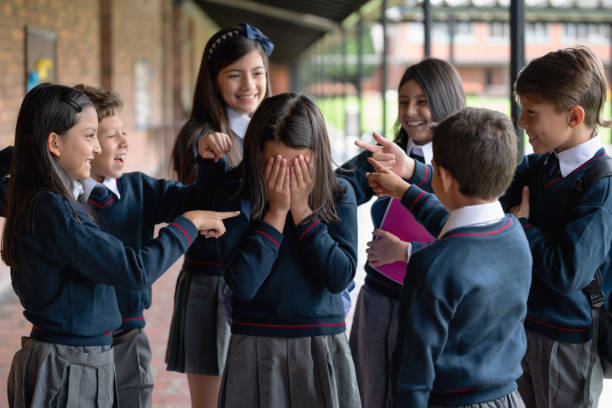
How To Write Bullying Scenes (12 Important Steps)
Bullying is an unsettling, yet unfortunately prevalent, issue that affects individuals across the world. In literature, the portrayal of bullying scenes can be a powerful means to shed light on this complex and often distressing social problem. The act of writing bullying scenes is not merely a creative exercise; it’s a responsible and sensitive endeavor…
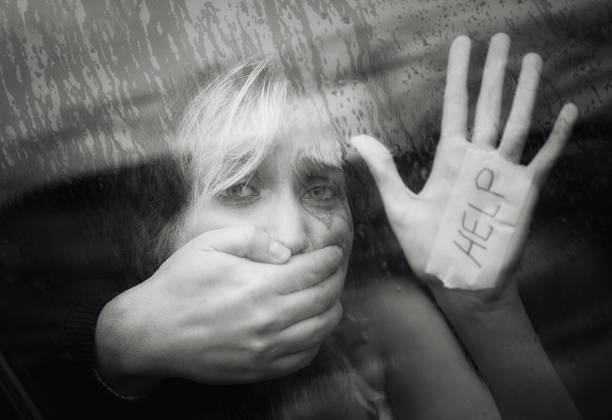
How To Describe Being kidnapped In Writing (15 Best Ways)
Describing the harrowing experience of being kidnapped in writing is an intricate and sensitive endeavor, where the power of words is harnessed to evoke fear, empathy, and raw emotional intensity. Writers take on the profound responsibility of creating a narrative that navigates the dark corners of human suffering, examining the depths of human resilience and…

Describing a Sunset: Top Words & Phrases for Writers

Affiliate Disclaimer
As an affiliate, we may earn a commission from qualifying purchases. We get commissions for purchases made through links on this website from Amazon and other third parties.
As the sun begins to set and the sky transforms into a canvas of brilliant colors, it’s difficult not to feel a sense of awe and wonder. Describing a sunset can be a challenging task for even the most experienced writers. However, with the right words and phrases, it’s possible to capture the beauty and magic of this daily occurrence.
In this article, the top 100 words and phrases for describing a sunset will be explored. Whether you’re a seasoned writer or just starting, these descriptive words and phrases will help you convey the experience of a sunset in a way that is both vivid and captivating. From the warm hues of the sun to the cool tones of the sky, this guide will provide you with the tools you need to bring a sunset to life on the page.
Writing about a sunset can be a powerful way to connect with readers and evoke emotion. It’s an experience that is universal and timeless, one that has inspired artists and writers for centuries. By using the right words and phrases, you can transport your readers to a place of natural beauty and wonder. So, whether you’re writing a novel , a poem, or a personal essay, this guide will help you describe a sunset in a way that is both authentic and captivating.
The Science of Sunsets
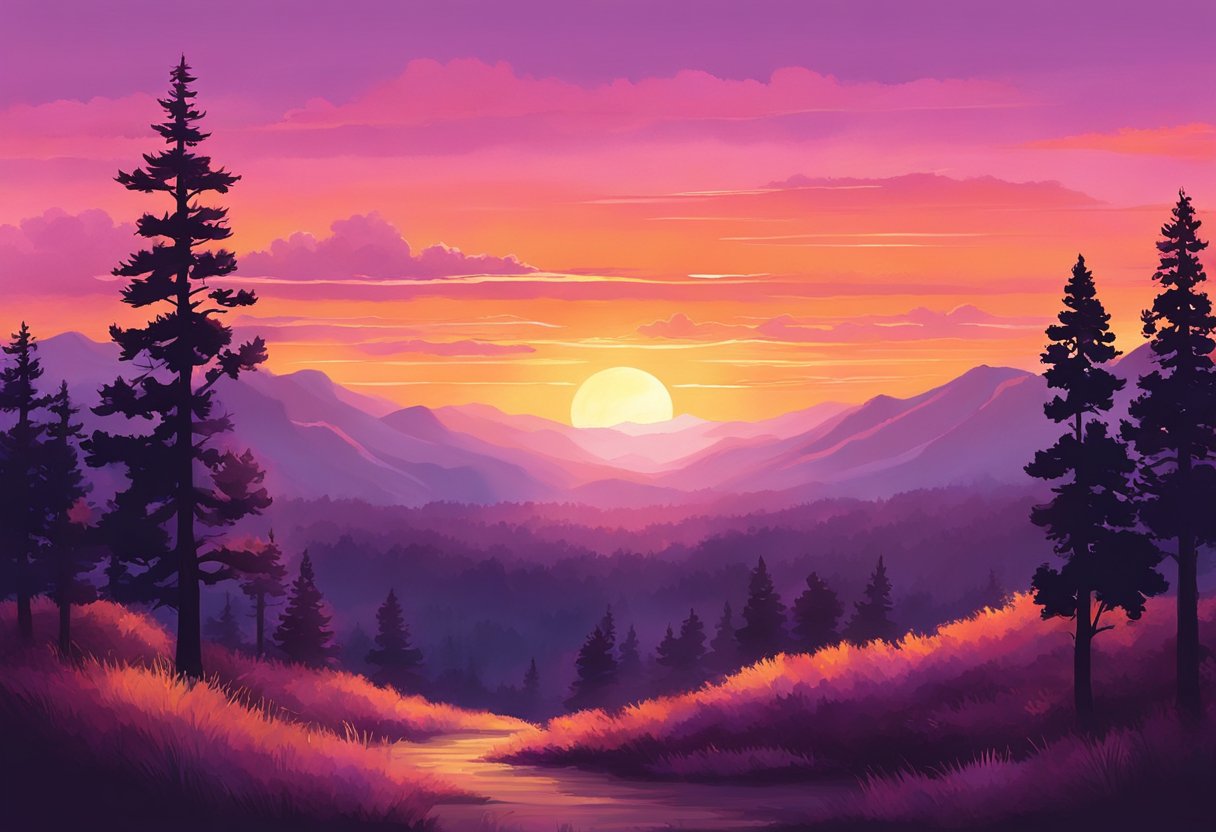
Sunsets are one of the most beautiful natural phenomena that occur every day. They are a result of the interaction between the sun, the atmosphere, and the Earth. Understanding the science behind sunsets can help writers describe them more accurately and vividly .
Atmospheric Phenomena
The atmosphere plays a crucial role in creating the colors and patterns we see during sunsets. As the sun sets, its light has to pass through more of the Earth’s atmosphere, which causes the light to scatter. This scattering causes the blue light to be scattered in all directions, leaving only the red, orange, and yellow light to reach our eyes.
Additionally, the presence of clouds can enhance the beauty of a sunset. Clouds can reflect and scatter the sunlight, creating a more colorful and dramatic display. The thickness and height of the clouds can also affect the colors and patterns of the sunset.
Color Spectrum and Light
The color spectrum is another important factor in creating a sunset. The colors we see during a sunset are a result of the visible light spectrum, which ranges from red to violet. As the sun sets, the light passes through more of the Earth’s atmosphere, causing the shorter wavelengths (blues and greens) to scatter, leaving the longer wavelengths (reds and oranges) to reach our eyes.
The intensity and angle of the sunlight can also affect the colors and patterns of the sunset. During the day, the sun is higher in the sky, creating a more blue and white sky. As the sun sets, the angle of the light changes, creating warmer and softer colors.
In conclusion, understanding the science behind sunsets can help writers describe them more accurately and vividly. The interaction between the sun, the atmosphere, and the Earth creates a beautiful and unique display every day. The colors, patterns, and atmospheric phenomena all contribute to the beauty of a sunset.
Descriptive Imagery in Sunset Writing
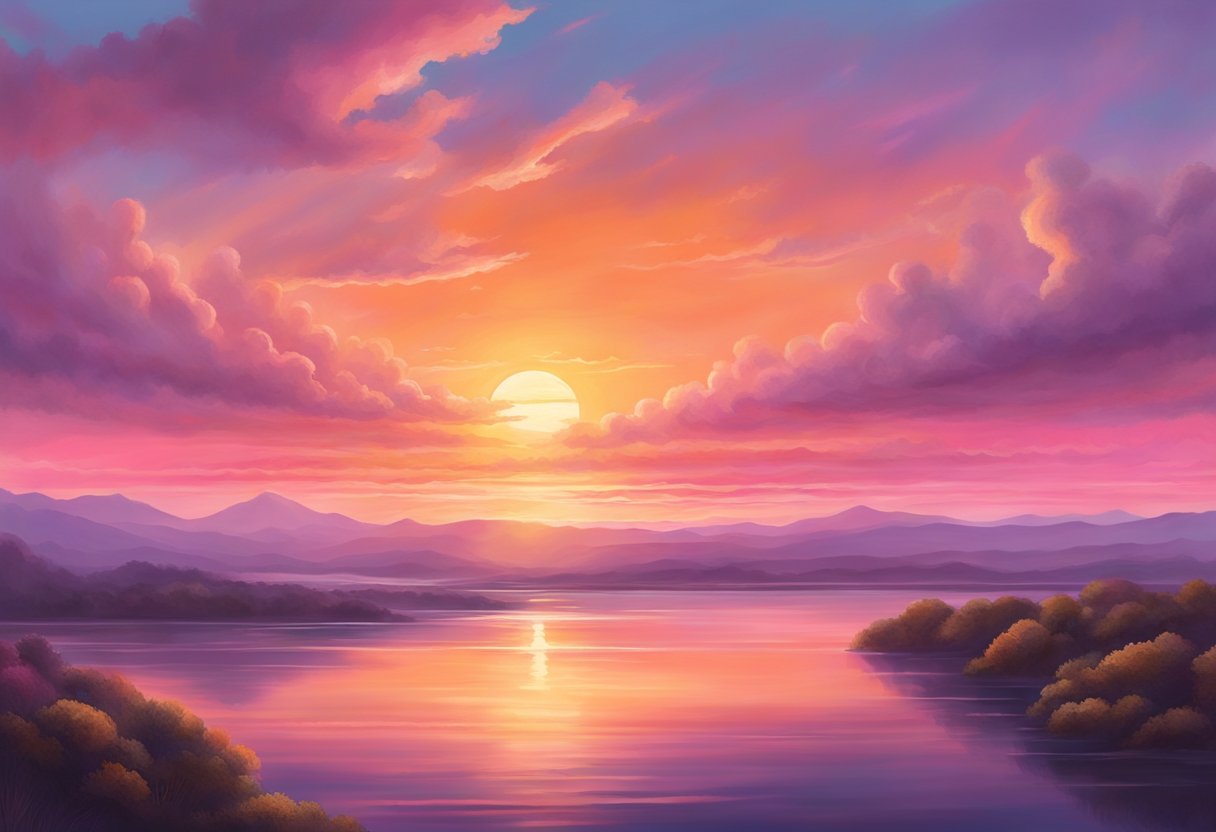
When it comes to writing about sunsets, the use of descriptive imagery is essential to create a vivid and engaging scene. This section will explore two key aspects of sunset writing: color descriptions and the use of adjectives and metaphors.
Color Descriptions
One of the most important elements of a sunset is its color. The sky can take on a range of hues, from soft pinks and oranges to fiery reds and purples. Writers can use a variety of color descriptions to capture the essence of a sunset, such as:
- Golden: This term can be used to describe a warm, glowing sunset, particularly when the sun is low on the horizon.
- Fiery: When a sunset takes on a more intense, red-orange hue, the term “fiery” can be used to convey the intensity of the colors.
- Vibrant: A sunset with bold, bright colors can be described as vibrant, conveying a sense of energy and excitement.
Adjectives and Metaphors
In addition to color descriptions, writers can use a variety of adjectives and metaphors to bring a sunset to life. Some examples include:
- Glowing: This term can be used to describe a sunset that seems to radiate light and warmth.
- Majestic: When a sunset is particularly grand and awe-inspiring, the term “majestic” can be used to convey its grandeur.
- Melting: This metaphor can be used to describe a sunset that seems to melt into the horizon, creating a sense of peacefulness and tranquility.
By using a combination of color descriptions, adjectives, and metaphors, writers can create a sunset scene that is both beautiful and engaging. Whether you’re writing a novel, a poem, or a descriptive essay, these techniques can help you capture the magic of a sunset and transport your readers to another world.
Emotional and Symbolic Meanings
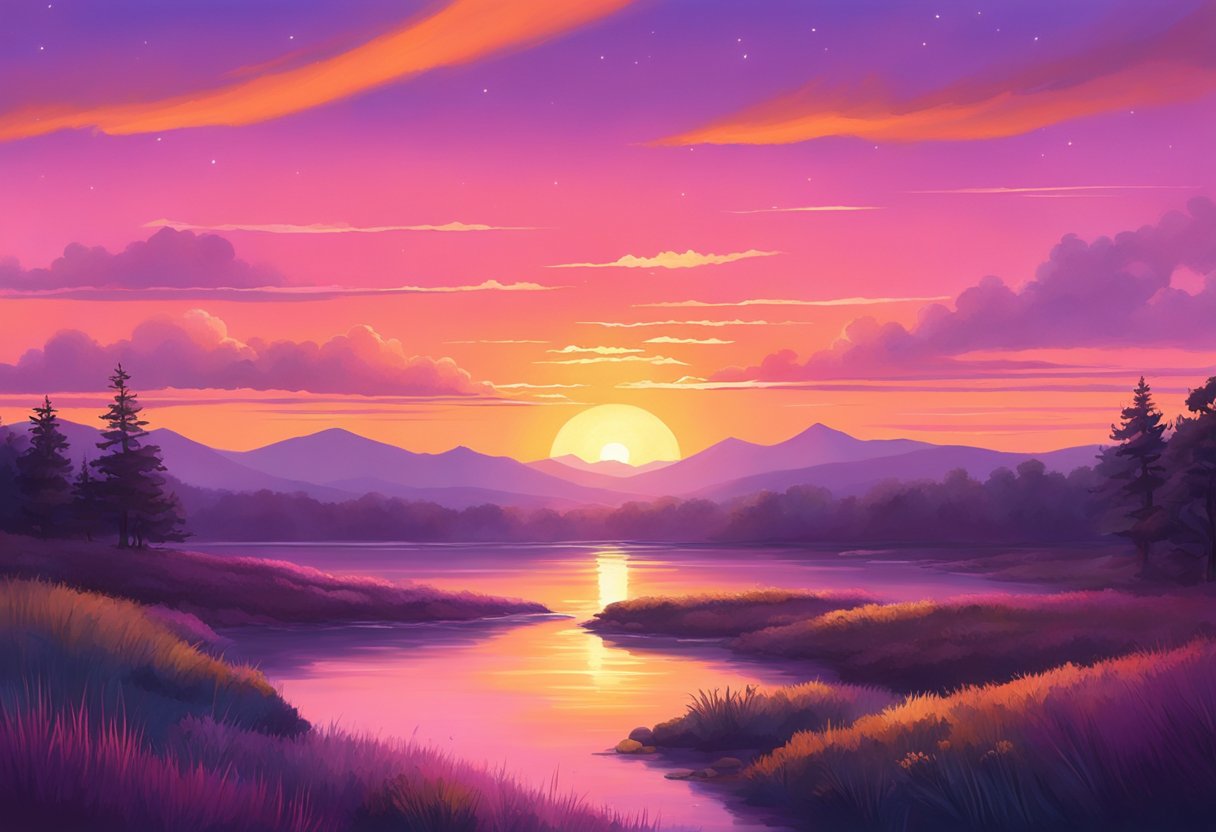
Romantic and Peaceful Connotations
Sunsets have long been associated with romantic and peaceful connotations. The warm hues of orange, pink, and red that paint the sky as the sun sets can create a mood of tranquility and relaxation. The soft, warm light can also evoke a sense of intimacy and romance, making it a popular setting for romantic moments and proposals.
In literature and poetry, sunsets have been used to symbolize the end of a day and the beginning of a new one. They can represent the passage of time and the fleeting nature of life, but also the hope and promise of a new day. The beauty of a sunset can inspire feelings of awe and wonder, reminding us of the beauty and complexity of the natural world.
Endings and Beginnings
Sunsets are often associated with endings and beginnings. As the sun sets, it marks the end of the day and the beginning of the night. This transition can symbolize the end of one phase of life and the start of another, or the closing of one chapter and the opening of a new one.
The colors of a sunset can also represent different emotions and moods. For example, a fiery red sunset can symbolize passion and intensity, while a soft pink and purple sunset can represent tranquility and calmness. The colors can also reflect the emotions of the characters in a story, creating a powerful and evocative scene.
Overall, sunsets are a rich source of inspiration for writers and poets. They can evoke a wide range of emotions and moods, from romantic and peaceful to melancholic and contemplative. By using the right words and phrases, writers can create vivid and memorable descriptions of this beautiful natural phenomenon.
Capturing the Sunset Experience
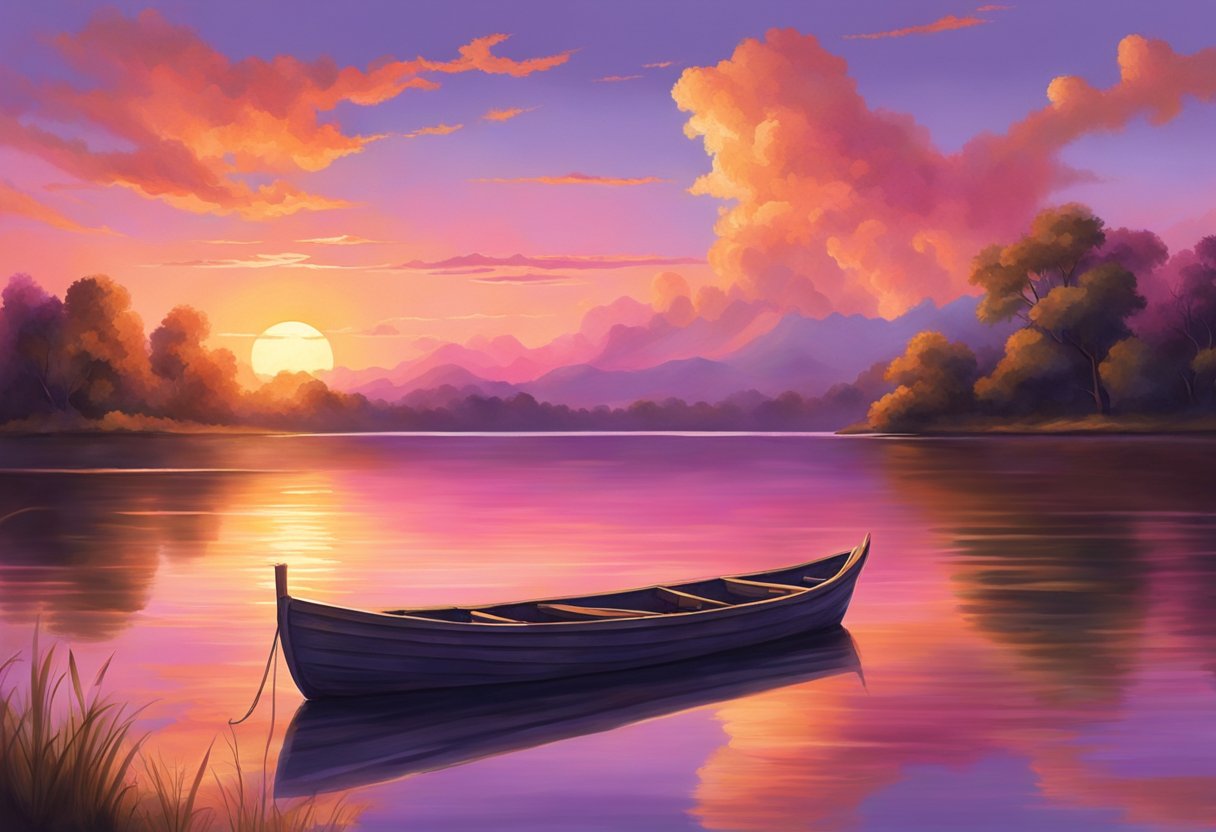
Watching a sunset can be a truly magical experience that can evoke a range of emotions in a person. As a writer, it is important to be able to capture this experience in words that will allow the reader to feel like they are right there with you. This section will provide some tips on how to do just that.
Sensory Details
The key to capturing the sunset experience is to use sensory details. This means describing what you see, hear, smell, taste, and feel. For example, you might describe the warm glow of the sun as it sets below the horizon, the sound of the waves crashing on the shore, the salty smell of the ocean, the taste of the salty air on your tongue, and the feel of the sand between your toes.
Using sensory details will help to create a vivid and immersive experience for the reader, allowing them to feel like they are right there with you, watching the sunset.
Temporal Elements
Another important aspect of capturing the sunset experience is to pay attention to temporal elements. This means describing the fleeting nature of the moment, and how it changes over time. For example, you might describe how the sky changes from bright orange to deep red as the sun sets, or how the shadows grow longer as the sun sinks below the horizon.
By paying attention to temporal elements, you can create a sense of urgency and excitement in your writing, and help the reader to feel like they are experiencing the sunset in real-time.
Overall, capturing the sunset experience requires a combination of sensory details and temporal elements. By using these techniques, you can transport the reader to the beach, and allow them to experience the magic of a sunset for themselves.
Influence of Sunsets on Art and Culture
Sunsets in literature.
Sunsets have long been a popular theme in literature, capturing the imagination of poets and writers alike. From the romanticism of Keats to the modernism of Hemingway, sunsets have been used to convey a range of emotions and ideas. Poets have often used sunsets as a symbol of the passage of time, the fleeting nature of beauty, and the inevitability of death. In literature, sunsets are also used to create a sense of atmosphere and mood, setting the tone for a story or poem.
Sunsets in Visual Arts
Sunsets have also been a popular subject in visual arts, from the impressionist paintings of Monet to the modernist works of Rothko. Painters have used sunsets to convey a sense of beauty, awe, and wonder. Sunsets are often depicted in a range of colors, from the warm oranges and pinks of a summer sunset to the cool blues and purples of a winter sunset. They are also used to create a sense of atmosphere and mood and to convey a range of emotions and ideas.
Overall, sunsets have had a significant influence on art and culture, inspiring poets, writers, and painters alike. They are a symbol of beauty and timelessness and have been used to convey a range of emotions and ideas throughout history.
Latest posts

Achieving Your Word Count Goals with Daily Sprints: A Guide
Many writers struggle with meeting their word count goals, whether it’s for a school assignment, a blog post, or a novel. It can be frustrating to stare at a blank page or screen and feel like you’re not making progress. However, there is a technique that can help you achieve your word count goals and…

Beat Burnout: Setting Reasonable Writing Expectations
Writing can be a fulfilling and rewarding experience, but it can also be exhausting and draining. Writing burnout is a real phenomenon that can affect anyone, from professional writers to students. When writers push themselves too hard, they can experience stress, lack of motivation, and even physical symptoms like headaches and fatigue. To avoid burnout,…

Dealing with Criticism and Rejection as an Author: Tips and Strategies
As an author, receiving criticism and rejection is an inevitable part of the writing process. It can be difficult to navigate the emotions that come with having your work scrutinized, but it’s important to remember that criticism and rejection are not personal attacks. Instead, they are opportunities for growth and improvement. One way to deal…
- Skip to main content
- Skip to primary sidebar

Writing Tips Oasis - A website dedicated to helping writers to write and publish books.
How to Describe a Sunset in a Story
By Isobel Coughlan

Are you writing a sunset in your novel? See how you can include the following 10 words. Read on to learn how to describe a sunset in a story.
1. Splendid
Something that’s very good and attractive .
“As the splendid sunset lit up the sky, crowds of admirers gathered to watch and take photos.”
“The man sipped his margarita and watched the splendid colors dance across the sky. It was the perfect end to a long day.”
How it Adds Description
“Splendid” is an excellent adjective to describe a pleasant sunset. This could imply that the sunset colors are very bright, but it could also show that the atmosphere to watch the sunset in is also very nice. Characters will likely feel very relaxed when watching a splendid sunset, which might even bring them joy.
Something that’s filled with bright colors (usually red and orange).
“The fiery sky burned bright above the coastal town. Visitors were in awe, but the locals were used to dramatic sunsets.”
“At sundown, make sure you watch the fiery sky. It’s an awesome sight!”
Sunsets are typically orange, red, or pink, and you can emphasize the hue of these colors via “fiery.” This adjective shows how bright the colors are, but it can make the sunset also feel mystical due to the word’s links to flames and burning. A character might be impressed or even frightened by this, especially if “fiery” sunsets don’t occur where they’re from.
3. Dazzling
Something that’s extremely bright and sometimes even blinding.
“The queen shielded her eyes against the dazzling sun. Watching it set was challenging, but the view was worth the struggle.”
“Ever since the dawn of time, the dazzling sunset had provided a nightly show to earthlings.”
The sun isn’t only bright during the day! Sunsets can also be “dazzling.” This word shows that the sunset is very bright, to the extent that viewers cannot view it while it goes down. Some characters might find it hard to watch if their eyes are sensitive, but they may try anyway, as the sunset is still beautiful.
Something that’s very extreme in degree or strength.
“The intense sunset heated the town, leaving some bystanders with sunburns despite the fact it was evening time.”
“She glanced up at the intense sky in wonder. Never before has she seen a sunset with so many shades.”
No sunsets are the same, and you can highlight how special your fictional sky is via “intense.” This adjective shows that the sunset is greater in size or brightness, and some characters might see this as a good sign from a higher power. Alternatively, an “intense” sunset could make a character fearful, as they may interpret it as a bad sign.
Something that’s not exciting or interesting .
“The dull evening sky was nothing compared to the sunsets of Mykonos.”
“He wished for a bright sky on his birthday, but all he received was a dull sunset and thick clouds.”
“Dull” contrasts the typical image of sunsets, but it’s perfect for describing a sky that leaves you wanting more. “Dull” sunsets might be less colorful, boring, or obscured by clouds. If you have a character who loves sunsets, this will likely frustrate them and leave them in a bad mood.
6. Heavenly
Something that’s very beautiful and linked with the religious idea of heaven .
“The heavenly sunset left the viewers feeling peaceful and at one with nature.”
“As the sun lowered, the heavenly sky was painted in shades of pink, purple, and red.”
You can use “heavenly” to link the sunset to religious ideas of heaven, thus portraying it as a very pleasant experience. This will likely make characters happy, and the beauty of the situation could even bring them internal peace for a few moments.
Something that’s very clear or bright in color.
“The sunset was so vivid that it felt like an acid trip. Orange light fell everywhere you looked.”
“He booked the restaurant because it boasted an unobstructed view of Cancun’s vivid sunsets.”
If you simply want to show how brilliant the sunset’s colors are, “vivid” can help you paint the picture. “Vivid” shows your readers that the sunset has extremely clear colors and that the sunset is worth watching. A character might become mesmerized by the “vivid” sky, especially if there are multiple different colors, as this is a beautiful experience.
Something that’s very far away .
“Though the sunset was distant , he could feel the warmth of the sun on his skin.”
“She stared at the distant sunset and enjoyed watching the pink clouds slowly fade away.”
“Distant” shows how far away the sunset is from the characters or narrator. This can give your reader a better understanding of the setting and show the sunset is an unreal spectacle far removed from human life.
Something extremely big .
“The horizon was saturated with color, resulting in an immense sunset she’d never forget.”
“He glanced at the sky and was shocked to see an immense golden sunset had engulfed it.”
If you want to give the readers a sense of scale, “immense” can be used to show how big the sunset is. This implies that it takes up the whole sky, and this could make a character feel very small and insignificant in comparison.
10. Fleeting
Something that isn’t long and lasts for a short amount of time.
“Before she knew it, the fleeting sunset had finished, and the stars had enveloped the night sky.”
“Though the pink and red sunset was fleeting , the townspeople would remember it forever.”
“Fleeting” showcases how fast the sunset occurs, and this could make it even more special as not everyone sees it. Some characters may even make elaborate plans to ensure they get to see a rare “fleeting” sunset, which further implies how special the sight is.

12 Sun, Sunrise & Sunset Metaphors for Writers
The sun is one of the most common contextual features of a setting that we write about. But it’s hard to come up with creative new ways to talk about something that has been discussed in countless books over Millenia. Below, I’ve compiled some creative sun metaphors that can help you break through that writer’s block and find the perfect setting description in your story.
After exploring metaphors for the sun, I’ll also provide some further adjectives and color descriptions that can help add flair to your writing, and create the perfect image in your reader’s mind.

Sun Metaphors and Similes
1. it slipped through my fingers.
You can picture in your mind sunrays on your hand and, with your fingers outstretched, some of them passing through the gaps in your fingers to lay on the ground below. To say it slipped through your fingers is metaphorical because it didn’t literally slip through anything. It didn’t slide or bounce or refract off your fingers at all. In fact, the it is a long, long way away. Rather, it’s the sunrays that pass between the fingers. But we can be much more creative and visual in our description than to say “the sun rays passed between my fingers” – so we say “it slipped through”.
2. The Blazing Sun Mocked Me
This is an example of personification of the sun. In this metaphor, the sun isn’t a friend but a tormentor. An example of a time when it might mock a protagonist is when they’re out on a hike through the desert. The protagonist is exhausted and dehydrated, with a long way to walk in the heat of the day. Here, we might imagine the protagonist being along and feeling as if the sun is their only company. But the heat means it isn’t a friend but an enemy, mocking you as you try to escape its heat.
Related: A List of Summer Metaphors, Similes and Idioms
3. It Peeked Through the Clouds
We use this metaphor for the moon as well. Imagine the clouds obscuring the sun’s view, but as the clouds part, it seems like it “peeks out” at you to take a look. This is another example of personification. Of course, an object without personality or a brain can’t take a peek at anything. But this personification helps us to create an image in our minds.
This metaphor can be used at the end of a storm to show the end of the storm and the return to better weather.
4. It is a Golden Coin
When I took college classes in creative writing, my professor shared a book he wrote, and it opened with the line: “the sun flipped a golden coin”. I’ve always remembered it and banked this in my mind as a great way to start a story. Others have had their own adaptations of this, such as calling the sun a golden orb or medallion in the sky ( See Also: Sky Metaphors ).
5. The Sun Chased away the Clouds
Here again we have personification. Of course an inanimate object can’t chase anything or anyone! But what is happening here is the description of the changes in the weather as a battle between different elements. The clouds are being chased like a sheepdog chases sheep, to return to its rightful position as the top dog in the skies.
6. It Stood Watch over its Realm / Looked over You
We can imagine the sun being the ruler over us. It sits so far overhead and is visible from just about anywhere you are (so long as you’re outside). It almost feels like it’s watching us constantly, standing guard. Again, this is of course personification – it doesn’t really do any watching at all! If we were to consider it to be like a god , we can imagine it’s watching us and passing judgement on us all day long.
7. It Smiled Upon Me
This one is another more positive, upbeat metaphor. The idea that you are being smiled at from above gives you a sense that you’re blessed and cared for throughout your day. This might be a metaphor you use if you feel as if you’ve had a lucky day or got some good news today. You can’t imagine using this metaphor when you’re going through hardship or feeling the punishing heat of rays on your skin.
8. The Sun’s Yolk
This metaphor calls the sun an egg! It may sound absurd, but if you look at it, it looks like a yolk from the inside of an egg. You might write “the yolk of the sun” as a metaphor to describe it, for example. This is your classic straight-up metaphor where you are directly calling one thing something else.
Sunrise Metaphors and Similes
9. god’s morning star.
This is a metaphor you might want to use if you’re writing a story from a religious perspective. To wake to “God’s morning star” is to see God in nature – be it a Christian, Muslim or Buddhist God, or even simply a pantheist . It might be seen as a moment to reflect on God, the beauty of the world, or even a moment for quiet prayer before eating.
The character might be waking feeling blessed, or even, feeling as if they’re downtrodden but continue to sustain their faith in their religion.
The sun is quite literally a star , so this is borderline figurative or literal (also depending on you believe in God!).
Related: A List of 19 Light Metaphors
10. The Sunrise Greeted me in the Morning
I love this metaphor. I can imagine someone pulling open the curtains and feeling joyful about their day ahead. When the curtains open, the sun is revealed – shining big and bright right back at the protagonist. The sun is a symbol of the person’s mood and greets or “welcomes” you to a day you’re looking forward. Here, it is being personified, which means you’re giving human features to non-human things.
Related Sun, Moon, Sky and Stars Articles:
- Red Sky Symbolism
- Sunrise Symbolism
- Sunset Symbolism
- Morning Symbolism
- Harvest Moon Symbolism
- Orange Sky Symbolism
- Sun and Sunrise Sayings
- Morning Star Symbolism
- Symbolism of the Sun
- Night Symbolism
- Darkness Symbolism
Sunset Metaphors and Similes
11. the sun succumbed to the moon.
This is a description you might use at the end of the day as night falls. Here, we can imagine the sun and moon taking shifts (there’s another metaphor for you!). They swap each 12 hours, almost like they’re in an unending battle. Here, the sun is the loser, succumbing to the moon (or night), to “retreat” through night.
12. It went to Bed
This is a metaphor to explain the coming of the night. Just as we go to bed, we can also imagine that orb in the sky going to sleep for the night. We shape the patterns of our lives around the night and day, so it makes sense for us to project some of our behaviors back onto the sun itself. This, again, is a form of personification where it’s being given the trait of an animal or human – the idea of going to bed!
Read Also: A List of Nature Idioms and Nature Metaphors
Colors to Describe the Sun
- Yellow – This is probably the most common color that comes to mind. On a clear day in the middle of the day, we’d expect its color to be yellow.
- Amber – This is the color you might expect to see during dusk or early in the morning.
- Copper – We’ll often use “copper” as an adjective in creative descriptions, such as “the scorching copper sun”.
- Honeycomb – This is the color you might experience in a certain ambiance, such as in a forest where the rays slip through the leaves and spot the forest surface with honeycomb colors and patterns.
- Golden – Like Amber, we might use this descriptive color when the atmosphere is thick at dawn or dusk.
Adjectives to Describe the Sun
- Blazing – A term you might use on a particularly hot day.
- Flaming – Similar to blazing – for hot days.
- Glowing – A good term for sunrise or sunset when there is a golden color in the air.
- Shining – A good term for the middle of the day.
- Scorching – Another one for hot days.
- Scolding – Again, this adjective describes the heat of the day.
- Licking – When you can feel rays dancing on your skin.
- Tickling – Similar to licking.

Sun metaphors can help enhance your writing and make it more descriptive. Aim to create an image in your reader’s mind by using adjectives and colors that match the mood you are trying to set. You can use different metaphors or idioms for different times of day or moods of your protagonists.
Other metaphors you can use in your writing to enrich it include happiness metaphors and fear metaphors.

I’m Chris and I run this website – a resource about symbolism, metaphors, idioms, and a whole lot more! Thanks for dropping by.
Describe Sunset: Captivating Colors and Serene Scenes Explained
By: Author Paul Jenkins
Posted on October 31, 2023
Categories Creativity , Art , Education , Self Improvement
Sunsets have a unique charm that captivates our hearts and minds. Often regarded as symbols of beauty, change, and the ephemeral nature of life, they never fail to amaze us with their incredible colors and breathtaking vistas.
As you learn to describe sunsets, you’ll not only enhance your writing skills but also gain a deeper connection with the world around you.

Understanding how to describe sunsets efficiently and evocatively is essential for any writer, whether you’re a poet, a novelist, or simply someone who enjoys penning your thoughts in a journal.
By exploring key characteristics and the role of weather and location in creating stunning sunsets, you’ll be equipped with the necessary tools to paint vivid, emotional scenes that stir your readers’ souls.
Key Takeaways
- Sunsets offer rich opportunities for description, drawing on vivid imagery, color, and emotion.
- Weather and location play a significant role in shaping the unique qualities of each sunset.
- Mastering sunset descriptions can enhance your writing, connecting you and your readers to the beauty of nature.
Understanding Sunsets
Sunsets are a beautiful and awe-inspiring natural phenomenon that you may experience every day. They signal the transition from day to night and provide a perfect end to the day for many people.
In this section, we will delve into the science behind a sunset to help you appreciate it even more.

The Science Behind a Sunset
When you gaze upon a sunset, you are actually observing the refracted and scattered sunlight as it passes through the Earth’s atmosphere.
As the sun gets lower in the sky, sunlight travels through a greater amount of the Earth’s atmosphere, causing the shorter, bluish wavelengths to be scattered and dispersed, leaving the longer, reddish wavelengths more visible.
During the day, you might notice that the sky appears to be blue. This is due to the shorter wavelengths of blue light scattering more easily than other colors.
However, as the sun gets lower, its light passes through more of Earth’s atmosphere. This increased pathway causes the blue light to scatter even further away, making the red and orange hues more prominent.
You might also wonder why sunsets can be so varied in color and intensity. This is due to various factors, such as the presence of clouds, dust particles, and pollution that can alter the way light scatters in the atmosphere.
These factors can lead to a wide range of sunset hues, from soft pastel tones to vibrant, fiery displays.
So, as you enjoy your next sunset, remember that it’s not just about the beauty of the moment but also a fascinating interplay of light, the Earth’s atmosphere, and the conditions in the sky. And with this understanding, you can fully appreciate the perfect end to your day: a mesmerizing sunset that transitions you into the night.
Characteristics of a Sunset
Colors of a sunset.
As you witness a sunset, you’ll be amazed by the variety of colors that paint the sky.
The beauty of a sunset lies in its vibrant hues, which can include shades of red, orange, yellow, purple, and pink. These colors often blend together, creating a breathtaking sight.
If the sky is clear, you might notice a golden glow surrounding the sun, while clouds can add depth and drama to the scene.
Reds and oranges are particularly prominent during sunsets because these colors have longer wavelengths and can travel greater distances through the atmosphere.
As the sun descends, the light filters through more of the Earth’s atmosphere, causing the shorter wavelengths, such as blues and greens, to scatter. This leaves the fiery reds and oranges to dominate the sky, intensifying the overall beauty.
Transition from Day to Night
The transition from day to night during a sunset is truly magical. The fading light creates a dramatic contrast between the bright, burning colors of the sun and the impending darkness of twilight.
This is a time when the world seems to slow down, allowing you to appreciate the colorful display as it unfolds.
As the sun sinks closer to the horizon, its glow starts to diminish, making way for the deep purples and blues of dusk.
The last rays of sunlight cast a luminous effect upon the clouds, turning them into a canvas for the final moments of the day. Gradually, the vivid colors give way to the darkening night sky, completing the breathtaking transformation from day to night.
The Role of Weather and Location
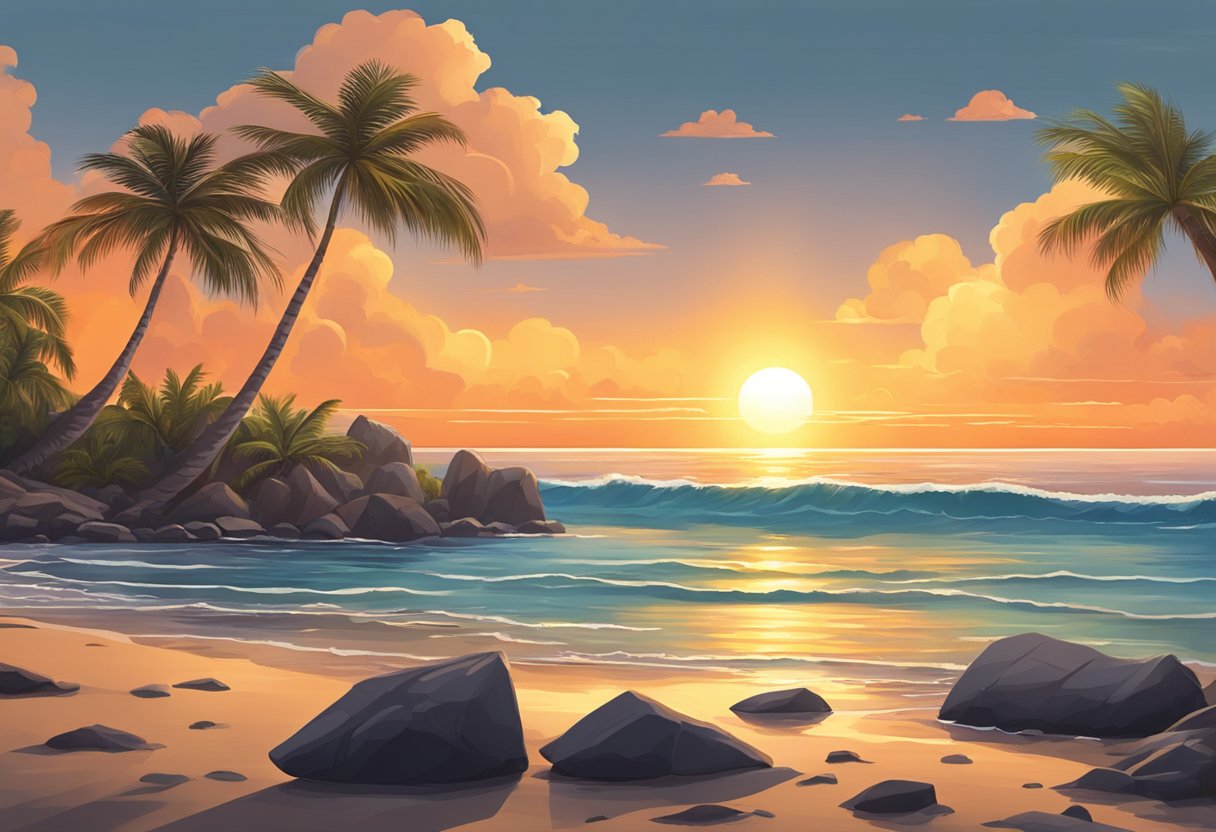
Effect of Clouds
When it comes to sunsets, clouds play a crucial role in developing those vibrant, glowing colors you adore. As light travels through the atmosphere, it interacts with particles and molecules, scattering the sunlight and creating a beautiful spectrum of colors.
When the sky is scattered with clouds during the evening, it provides a canvas for the sunlight to paint, which results in a visually captivating sunset.
Sunsets at Sea
As you stand by the sea, you might notice the sunsets appearing even more breathtaking. This is because there is usually less air pollution and more open space, allowing sunlight to travel without much obstruction.
Additionally, the calm surface of the water enhances the sunset effect by reflecting the colors and creating a mesmerizing, mirrored view of the sky above.
Sunsets Across Different Regions
Depending on your location, the characteristics of sunsets may vary significantly. In tropical regions near the equator, the atmosphere is typically warmer and more humid, which intensifies the glowing and fiery hues of the sunsets.
Meanwhile, in arid regions like deserts, the sunsets tend to be hotter and have bolder colors.
On the other hand, if you are in a colder region, you might experience more subtle hues and a softer glow during the evening.
Sunsets in Art and Poetry
Sunsets in Literature
Sunsets have always been a favorite subject of poets and authors. The golden, romantic glow of twilight sets the perfect mood for expressions of love and the peaceful ending of a day.
As you read these works, pay attention to the use of vivid adjectives and metaphors. You’ll notice how these literary devices bring sunsets to life, from dazzling colors to intense emotions.
Radiant and colorful descriptions create a vivid and unforgettable picture in your mind. Remember, the way characters in literature experience and appreciate sunsets can reveal their inner thoughts and feelings.
Sunsets in Painting
In paintings, sunsets are often portrayed as vibrant displays, with dazzling combinations of gold, orange, and red hues.
Some artists even include visual metaphors, such as a symphony of colors, to evoke a sense of wonder and beauty.
As you observe these paintings, take note of the skillful use of color, light, and reflection techniques to capture the intensity of the scene. You can learn a great deal about creating atmosphere in your own artwork by studying these masterpieces.
Sunsets in Photography
Photography provides another medium for capturing the breathtaking beauty of sunsets.
With the right camera settings, a photographer can evoke the warm, romantic atmosphere of a golden hour, illuminating the emotions and moods of their subjects.
Look at different photos of sunsets, analyzing how photographers utilize angles, lighting, and composition to create their images. By doing so, you can gain inspiration for your own sunset photographs and develop a unique artistic style.
The Emotional Significance of Sunsets
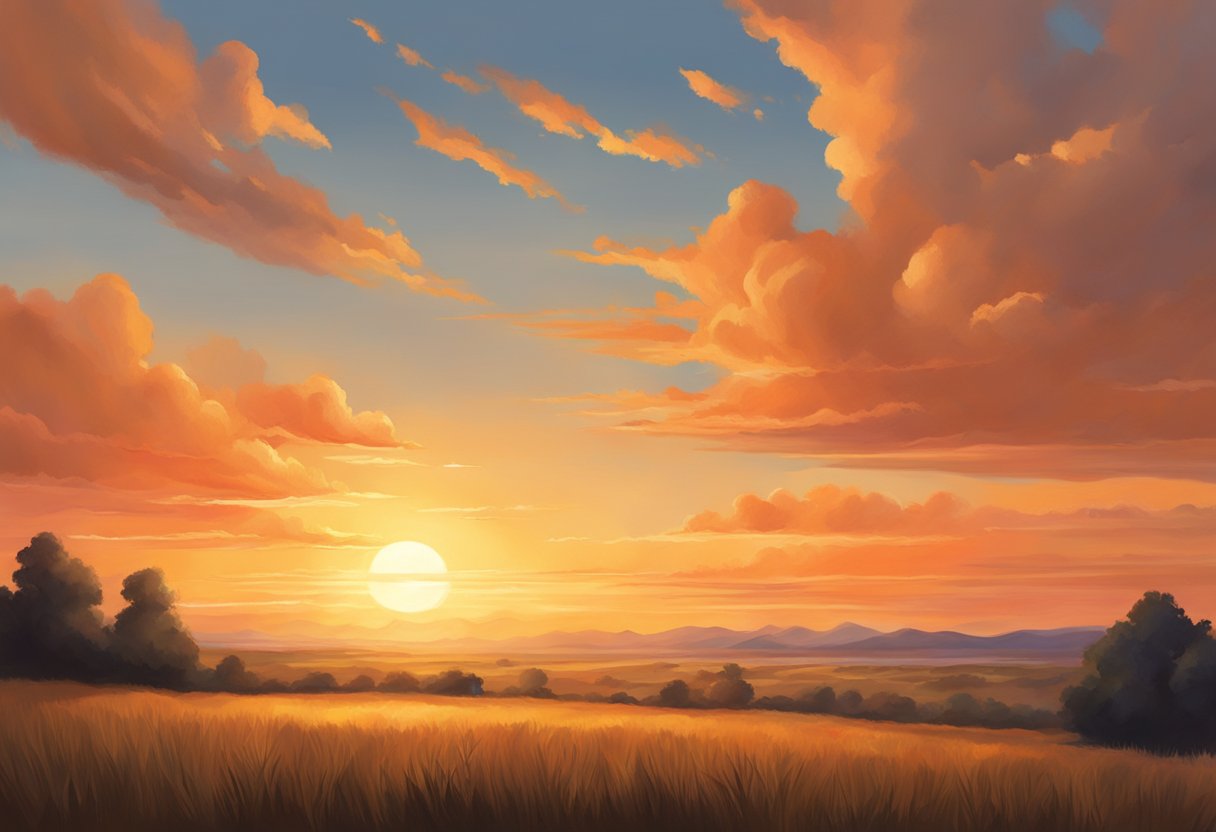
Sunsets and Mood
Sunsets truly are a gorgeous sight. You might find that the brilliant colors and majestic scenes of the twilight sky evoke a peaceful and serene atmosphere that makes it the perfect time to admire its beauty.
The intense colors and glowing sky can undoubtedly lift your mood, and it’s no wonder that sunsets are often considered a romantic and heartwarming event.
When you observe a sunset, you might feel a sense of hope as the dazzling colors reflect upon the clouds.
The vivid and magnificent display can inspire a sense of wonder, providing a moment of tranquility in your busy day.
As the sun sets and day turns into night, allow yourself to bask in the feeling of renewal that comes with the changing sky.
Sunsets and Symbolism
In various cultures and throughout history, sunsets have symbolized much more than just the end of the day. Their radiant glow represents a transition, as the world shifts from the energetic warmth of day to the calm coolness of night.
Sunsets can be seen as a symbol of love, as the serene hues of the sky create a romantic ambiance that warms your heart.
Furthermore, sunsets serve as a reminder of the eternal cycle of life. The flaming sky signifies the completion of another day, drawing you into a moment of gratitude and introspection.
This splendid phenomenon encourages you to appreciate the passage of time and the incredible power of nature, which shapes our lives in countless ways.
Take in the dazzling display, and you’ll find that sunsets hold much more than just a visual appeal. They provide a moment to reflect and reconnect with yourself, celebrating the beauty and joy that life has to offer.
Frequently Asked Questions
How does a sunset look on the beach.
A sunset on the beach offers a remarkable sight, with the sun gradually descending towards the horizon and reflecting on the water’s surface. You can witness a beautiful sky palette, blending shades of orange, pink, and purple. The gently crashing waves and the contrasting colors create a serene and picturesque scene that can leave a lasting impression.
What expressions are used to describe a sunset in poetry?
Poets often use metaphorical and vivid expressions to capture the essence of a sunset. Phrases like “a dance of light before evening” and “the sunset was a pyre” can evoke strong imagery of the sun’s breathtaking descent. Other terms like “radiant” and “luminous” help paint a vivid picture of the glowing nature of the setting sun in the reader’s mind.
What are the characteristics of a sunset?
Sunsets exhibit beautiful and unique characteristics that change daily due to factors like cloud cover, location, and atmospheric conditions. Some common features include gradients of warm colors like orange, pink, and red, followed by cooler hues like purple and blue. The golden hour, just before sunset, provides stunning lighting for photography, while dusk brings a tranquil atmosphere as the twilight fades.
How would you convey the beauty of a sunset to someone with visual impairment?
To convey the beauty of a sunset to someone with visual impairment, consider describing the sensations and emotions tied to the experience. You could mention the warmth of the sun on their skin as it sets, the soothing sound of waves for a beach sunset, or the calming effect the surrounding environment might have. Use vivid language to paint a mental picture, highlighting the blend of colors, the gradual fading of light, and the fleeting nature of the moment.
What are some quotes on sunsets and their descriptions?
Here are a few quotes that encapsulate the beauty of sunsets:
- “Sunsets are proof that no matter what happens, every day can end beautifully.” – Kristen Butler
- “There’s a special quality to the loneliness of dusk, a melancholy more brooding even than the night’s.” – Ed Gorman
- “Every sunset is an opportunity to reset.” – Richie Norton
- “When the sun has set, no candle can replace it.” – George R.R. Martin
How can one describe a sunset in a painting or photograph?
Capturing the beauty of a sunset in a painting or photograph requires attention to color, composition, and lighting. Focus on the rich hues and the gradients present in the sky, the contrasting silhouettes of the landscape, and the way sunlight filters through elements like clouds, trees, or buildings. Try to evoke the atmosphere and emotions associated with a sunset, such as tranquility, nostalgia, or awe. Pay attention to details like reflections in bodies of water and how the colors interact to create a visual representation that truly showcases the sunset’s splendor.
- How to Cite
- Language & Lit
- Rhyme & Rhythm
- The Rewrite
- Search Glass
How to Describe a Sunset
Describing a sunset in an essay, poem, book or short story requires descriptive adjectives and the use of literary devices, such as imagery, metaphors and symbolism. Sunsets represent warmth and beauty, often signifying an important season in a character's life, so descriptions tend to have a peaceful, melancholy tone. When writing about sunsets, focus on visual aspects of the sky and how the sunset makes the characters in your story or poem feel.
Use Literary Devices to Develop Imagery
Use literary devices, such a symbolism and imagery, to describe the natural beauty, warmth and transitional elements of a sunset. For example, Emily Dickinson examines the wonder of nature by describing the rising and setting sun in her poem, "I'll Tell You How the Sun Rose." She uses the metaphor of yellow-hued children climbing and playing until it gets too dark to play any longer to describe the changing sunset colors, from yellow to gray. Hazel Hall uses imagery in her poem "Twilight" to show how the sunset affects grass, flowers and plants by causing them to close up for the night. Her poem considers how the sunset transforms the natural world.
Choose Descriptive Adjectives and Adverbs
Focus on descriptive language, including compelling adjectives and picture-perfect adverbs to help readers visualize the sunset. Use precise language, explicit vocabulary and well-constructed analogies to detail the complexities associated with sunsets, according to the Core Curriculum State Standards Initiative for 11th- and 12th-grade students. Discuss color variations in the sky and how the setting sun casts shadows across the ground. Think of examples that remind you of sunsets, such as changing seasons, the process of aging or an ending to one life experience to start another.
Discuss the Repeated Cycle of Sunsets
Detail the enduring, recurring, daily characteristics of sunsets. Poets such as Henry Wadsworth Longfellow and Robert Bridges, in their respective poems "Sundown" and "The Evening Darkens Over," discuss how sunsets always lead to night and darkness. Both poets associate sunsets with closure and an end to one's daily experiences. Describe the sunset by focusing on its brief, yet important, role in nature. Use adjectives such as perpetual, relentless, timeless, unremitting and unfailing, to describe sunsets.
Establish the Tone and Mood
Discuss ways a sunset creates a mood or establishes the tone for a poem or a story. For example, in the book "The Outsiders" by S.E. Hinton, two main characters from different socioeconomic backgrounds discuss the beauty of the sunset and its ability to bridge barriers to unite people. Describe how the sunset makes characters feel, such as relieved, satisfied or hopeful. Use emotion-filled adjectives, such as majestic, endless, inspirational, glowing, romantic, serene or captivating to describe the sunset.
- Common Core State Standards Initiative: English Language Arts Standards -- Writing -- Grade 11-12
- Poetry Foundation: The Evening Darkens Over; Robert Bridges
- The Poetical Works of Henry Wadsworth Longfellow, Volume 4; Henry Wadsworth Longfellow
- The Outsiders; S.E. Hinton
As curriculum developer and educator, Kristine Tucker has enjoyed the plethora of English assignments she's read (and graded!) over the years. Her experiences as vice-president of an energy consulting firm have given her the opportunity to explore business writing and HR. Tucker has a BA and holds Ohio teaching credentials.
- Skip to primary navigation
- Skip to main content
- Skip to primary sidebar

WRITERS HELPING WRITERS®
Helping writers become bestselling authors
Setting Description Entry: Forest
August 23, 2008 by BECCA PUGLISI

green, brown, dead fall, fallen trees, logs, branches, twigs, fallen leaves, ferns, underbrush, moss, brambles, thickets, ivy, berry bushes, pine needles, pine cones, acorns, insects, rabbits, birds, squirrels, lizards, mice, foxes, spider webs, deer, sun-dappled, shady, shafts…
Sounds branches creaking, feet shuffling through detritus, squirrels chattering, leaves rustling, wind whistling around trunks/disturbing the leaves, birds singing, insects humming/ churring, rustle of animals rooting in underbrush, scrabbling of lizards on tree bark, limbs..
Smells tree smells (pine, etc), wildflowers, earthy smell, animal scents, rotting wood, fresh, stale, dry, damp, wet, scents on the wind from nearby places (water, wood smoke, ocean), wild mint/herbs, decay (bogs, stagnant pools of water, dead animals), skunks, skunk weed…
Tastes earthy air, sweet/sour berries, nuts, mushrooms, wild onions, seeds, bitter, mint, gritty, mealy, meaty, relish, savor, sample, salty, acidic, sweet, flavorful, sour, tart, flavorless, swallow, mild, nutty, relish…
Touch rough tree bark, kiss of falling leaves, branches slapping, uneven ground, knobby roots underfoot, sticky sap, underbrush that tangles/grabs, prickle of briars, slick leaves, twigs snagging at hair/scratching face, tickle of hanging moss, spider web strands on skin, soft…
Helpful hints:
–The words you choose can convey atmosphere and mood.
Example 1: I lifted my face, letting the light and shadow dance across my skin. Bees hummed in and out of the pennyroyal. I inhaled its minty smell and continued on, delighting in the sound of my feet sliding through the leaves.
–Similes and metaphors create strong imagery when used sparingly.
Example 1: (Simile) The trees lashed and crashed against each other like drum sticks in the hands of a giant…
Does your setting take place at night? Check out this similar Entry: WOODS AT NIGHT
Think beyond what a character sees, and provide a sensory feast for readers

Setting is much more than just a backdrop, which is why choosing the right one and describing it well is so important. To help with this, we have expanded and integrated this thesaurus into our online library at One Stop For Writers . Each entry has been enhanced to include possible sources of conflict , people commonly found in these locales , and setting-specific notes and tips , and the collection itself has been augmented to include a whopping 230 entries—all of which have been cross-referenced with our other thesauruses for easy searchability. So if you’re interested in seeing a free sample of this powerful Setting Thesaurus, head on over and register at One Stop.

On the other hand, if you prefer your references in book form, we’ve got you covered, too, because both books are now available for purchase in digital and print copies . In addition to the entries, each book contains instructional front matter to help you maximize your settings. With advice on topics like making your setting do double duty and using figurative language to bring them to life, these books offer ample information to help you maximize your settings and write them effectively.
Becca Puglisi is an international speaker, writing coach, and bestselling author of The Emotion Thesaurus and its sequels. Her books are available in five languages, are sourced by US universities, and are used by novelists, screenwriters, editors, and psychologists around the world. She is passionate about learning and sharing her knowledge with others through her Writers Helping Writers blog and via One Stop For Writers —a powerhouse online library created to help writers elevate their storytelling.
Share this:
- Click to share on Twitter (Opens in new window)
- Click to share on Facebook (Opens in new window)
- Click to share on Pinterest (Opens in new window)
- Click to share on LinkedIn (Opens in new window)
- Click to share on Tumblr (Opens in new window)
- Click to email a link to a friend (Opens in new window)
- Click to share on Reddit (Opens in new window)
- Click to print (Opens in new window)
Reader Interactions
October 11, 2021 at 6:06 am
That helped me a lot!
October 7, 2021 at 2:08 pm
I love descriptive writing but can you help me to write a forest setting description?
February 26, 2021 at 10:01 am
Thank you for this great help…☺️☺️
February 23, 2021 at 4:37 am
Thanks this helped a lot!
January 19, 2021 at 1:39 am
Lovely book, It helped me a lot thanks
August 19, 2020 at 10:54 pm
Are you lovely ladies planning to put these descriptions into an ebook? I’m enjoying all seven of your thesaurus books.
August 20, 2020 at 8:13 am
Hi, Michelle! I’m so glad you’re enjoying our books. Are you asking when the setting thesaurus is going to be turned into a book? If so, you’ll be happy to know that those books are published and available. You can find ebook information on our Bookstore page. https://writershelpingwriters.net/bookstore/
If you have other questions or need to clarify anything, just let us know!
July 13, 2020 at 8:35 pm
OMG! This is powerful. God bless you richly. Please ma, can you help me to proofread my short fiction. I’m begging in the name of God. I have written a short fiction, but no one to help me to proofread it. [email protected] . Thanks in anticipation.
July 14, 2020 at 10:44 am
Sorry, we are unable to do that, but if you join a writing group or have a good critique partner, they should be able to help you. Good luck and all the best. 🙂
May 21, 2020 at 4:59 pm
amazing thankyou so much 🙂
March 11, 2020 at 3:19 pm
thanks! these will help a lot with the forested settings in my book series: the elemental masters.
June 26, 2020 at 5:42 am
Oh wow, your books are absolutely amazing. I’ve read all of them
March 9, 2020 at 1:50 am
Thank you for this, however, could you also do the same setting description based on the setting of a beach? That would be extremely helpful for me. THank yoU!
March 7, 2020 at 10:28 pm
Hi, this is extremely helpful, but could you make another setting description, the same as this one, except about a beach scene? That would be super helpful for me. Thanks!
March 8, 2020 at 1:56 pm
Hi, Stacey! We actually do have a Beach entry. You can find it here: https://writershelpingwriters.net/2008/09/setting-thesaurus-entry-beach/ . And our TOC also contains a list of the entries you can find here: https://writershelpingwriters.net/occupation-thesaurus/
But if you’re looking for settings that we don’t have, you might consider checking out our website, One Stop for Writers. All of our thesaurus collection are there, and most of them have been expanded to include additional entries. For instance, here is the complete list of setting entries you can find at One Stop: https://onestopforwriters.com/scene_settings
Best of luck to you!
March 9, 2020 at 5:47 am
Thank you so much Becca, i just really appreciate it, i love the websites you gave me and it is simply WONDERFUL!!!
March 6, 2020 at 3:12 am
This is wonderful, thank you! Very helpful!
October 24, 2019 at 6:10 am
IT FANTASTIC
January 1, 2019 at 7:15 pm
this really helped me. thank you lol 🙂
July 12, 2017 at 1:21 pm
I am helping a friend open a bar in a small town…the lifestyle here is of the following: Fishing, boating on our two rivers….Wabash and Tippecanoe and hunting deer. Cannot come up with a name to incorporate both of the passions our customers would enjoy. I have gone to your description setting entry for ideas…but just can not gel together this duo!!! Help?
July 12, 2017 at 8:00 pm
Hi, Patti. I’m sorry, but I’m not clear on what you’re after. Are you looking for help coming up with a name for a fictional town?
October 5, 2014 at 2:41 am
THANKS VERY MUCH FOR SUCH A WONDERFUL WORK. MY DAUGHTER WILL HAVE A GOOD RESOURCE OF DESCRIBING WORDS.
February 29, 2012 at 1:40 pm
Thank you so much for this! I have been struggling with my forest scenes for the longest time, stuck on the same small handful of descriptors–this is brilliant. Thank you, thank you, thank you!
May 1, 2011 at 4:48 pm
Thank you very much for these amazing words! keep the work up!
March 7, 2011 at 7:54 am
Thank you so much. These beautiful words makes picturing a scene extremely easy.
February 1, 2011 at 2:13 pm
I absaloutly loved thease words i really needed them to help me get my English paper to life
January 25, 2011 at 6:47 am
It’s a great Help for me. I was looking for such post that could give some interesting wording to describe a greenery and forest scene.
Thank you very much 🙂
April 7, 2010 at 6:13 am
I showed my teacher and she said you rocked. Thank you 🙂
March 26, 2010 at 2:52 pm
Great help for my book! Thank you!
December 13, 2009 at 12:30 pm
Thanks. Great Guide for a descriptive piece of writing A*
December 11, 2009 at 12:26 am
Creatively helpful , specially to beginning writers like me. Thanks for this web.
October 2, 2009 at 10:38 am
very helpful thanxx cood u include more sentance exxampils thanx that wood be helpful! miss m
September 23, 2009 at 11:35 am
April 21, 2009 at 8:29 pm
I LOVE THIS!!!!!!!!! Just what I am writing about!!! THANKS!!!!!!!
August 24, 2008 at 1:17 pm
Thanks for the kind words. When Angela and I started this blog, one of our main goals was to keep it relevant to writers. Glad to know we’re doing alright on that front :).
August 24, 2008 at 12:07 pm
This is fabulous!! I love it!
August 23, 2008 at 8:02 pm
Angela and Becca, you one-hit wonders, you’ve done it again! You’re very good at relating to the reader (and making it easy on the writer).
August 23, 2008 at 5:51 pm
Great job. And I really like the drumsticks simile.
August 23, 2008 at 10:45 am
So perfect! Thanks! I love the simile and metaphor section!
[…] Forest […]
[…] is a forest entry already, but I think that at night the woods can be an entirely different setting, full of mystery […]
Type to search
- Privacy Policy
- Terms And Conditions
How To Describe A Sunset: Here’s A Passionate Expression.
You’re as beautiful as the sunset! Have you heard spouses use such phrases to describe their partners’ beauty? Such praises always creates a romantic atmosphere.
Sunsets are not only gorgeous. They’re one reason living things can survive on planet earth. The sun is a vast source of energy.
Describing a sunset would be one of the hardest things to do. But thanks to the creativity of poets and creative writers, we have been able to put together a list of inspiring description of a sunset.
Continue reading as we discuss how to describe a sunset.
How Can You Describe A Sunset?
A sunset is nothing but a glorious conflagration that blazed with eye-popping colors, and yet produced no warmth. These types of description suits a sunset. They make us understand and appreciate the beauty of sunsets.
Here are other lovely ways to describe sunsets.
Sky Of Fire:
The rising sun came with a sky of fire that lit up the entire cloud.
A perfect conclusion:
Sunsets are a definition of a perfect conclusion. They appear as silky, smooth collusions of sky burst red and yellow in the night’s calm.
Sunsets are a sigh of late summer days and dawns of restful winter evenings.
Symphony of color:
Sunsets are a symphony of colors, which sings humans and other living things to sleep. It continually changes in shape and color, especially if there’re clouds to display shape, color, and form.
Defines the spectrum of time:
Sunset marks the beginning and end of the day. When it rises, it marks the beginning of a new day. And when it sets, it signifies the end of the day.
Other terms used to describe sunsets:
- Magnificent
- Indescribably beautiful
Why Should You Take A Sunset Seriously?
Sunsets are always cute, romantic, and inspiring. They add color to the natural background of pictures. They also give people a reason to adore Mother Nature more.
Unfortunately, only a handful of people take out time to enjoy the calming and life-changing feelings sunset gives. Most people only do so during vacation, in an exotic hotel, beach, or park.
The truth is, the sun rises and sets every single day. And no rule states that one must be on vacation or in a beautiful environment to watch sunsets.
You can enjoy the beautiful moments that sunsets create every day regardless of where you find yourself. Plants and animals do. So then, why should we humans be left out?
If you’re looking for reasons to get up from your bed every morning to watch sunsets, you’re in the right place for some inspiration. Here good reasons to make watching sunsets a habit.
It helps you appreciate life the more:
Fast-paced life has made many people feel they no longer have time for many things. Impatience and materialism have become the order of the day.
Research conducted by psychologists at Stanford University Graduate School of Business, in conjunction with the Minnesota Carlson School of Management, has revealed something unbelievable about sunsets.
According to the study, participants that were made to watch sunsets explained that they felt they had more time, exhibited a high level of patience, and were more than willing to assist others.
Life is all about making yourself and the people around you happy. If everyone around you is happy, you too will become happy no matter what’s happening around you.
So, if you feel you no longer appreciate life or volunteering time to help others, as you should, set out time to watch sunsets from time and time. The wonders and beauty of Mother Nature will change your mind and life for good.
Sunsets can make you feel super energized:
Nature is the soul’s fuel. When you feel tired, a cup of coffee could replenish your lost energy. Coffee can also make you more mentally alert.
But do you know that you don’t need to drink coffee to replenish your energy anytime you feel drained? Research has provided insight into the benefits nature can offer humanity.
A simple connection with nature can help you feel energized. Nevertheless, you don’t need to feel depleted before making up your mind to connect with nature or watch the sunset. Nature offers tons of benefits besides re-energizing us. So, go out there and watch the sunset. Make it a habit.
Sunsets can uplift your mood:
Feeling down or stressed? Whatever the case may be, nature can help. Research has shown that watching the sunset for few minutes can have massive psychological effects on a person.
So, if you feel tired after a hectic day at work, don’t just step into your car and zoom off the next day. Try to spend time gazing at the sun before living for work. But if you’re afraid of running late to work, then you can watch the sunset when you arrive at your office.
No one would get mad at you for spending a couple of minutes outside.
It gives you an excellent reason to step out:
Most people spend the whole day or weeks indoors, working or for reasons best known to them. For some, the reason they haven’t stepped out is that they have nothing to do outdoor.
You can step out to watch the sunset every day. Make it the primary reason you step out of your home or office for a couple of minutes.
You’re not going to spend the whole day outside. Just a couple of minutes, and you’ll enjoy the enormous psychological and health benefits sunsets gives.
Sunsets can serve as your inspiration:
Have you ever bothered to ask why writers, painters, romantics, and poets wait for sunsets sometimes before focusing on their tasks? It’s because they needed some inspiration, which sunsets can offer in abundance.
So, if you’re a creative person and you need some inspiration, then feed your eyes with the mystical and vibrant colors that accompany a sunset . Allow the sunset to inspire you to create a poet, article, or painting that will keep your targeted audiences on their toes.
10 Beautiful Sunset Quotes
Quotes help to communicate one’s feelings in a clearer tone. Adding an object as beautiful as a sunset into a quote makes it lovelier.
There are diverse, inspiring, mood-lifting, and soul-touching sunset quotes out there that you can use.
Here’s a list of beautiful sunset quotes you can use.
- “Every sunset gives hope that the day would start and end beautifully.” – Unknown.
- “Whenever the sun is setting, forget about whatever you’re doing and watch it.” – Mehmet Murat Ildan .
- “Sunsets are so marvelous that the sun itself watches them every day via the infinite oceans’ reflections.” – Mehmet Murat Ildan .
- “A sunset can be blazing with brilliance and arouse all the yearnings and passion in the beholder’s soul.” – Mary Balogh.
- “Whenever I admire the moon’s beauty or sunset’s wonders, my soul expands in the worship of our creator.” – Mahatma Gandhi.
- “Sunsets are the sun’s fiery kiss to the night.” – Crystal Woods.
- “There are a sunrise and sunset every day, and both are entirely free. Do not miss so many of them.” – John Walton.
- “Love’s first stab is like a sunset, a blaze of color – pearly pinks, oranges, and vibrant purples…” Anna Godbersen.
- “Nature is a painting, as pictures of infinite beauty unfold, day after day, if only we possess the eyes to see them.” – John Ruskin.
- “It’s almost impossible for someone to watch a sunset and not dream.” – Bern Williams.
No one spends time watching the sun setting and remains in a bad mood. By thinking about the wonders of nature, gorgeous color varieties pouring down from the sky while watching sunsets, your mood would surely change for good.
It doesn’t matter if you had a hectic day at work or going through a rough time in your life. Devote time to watch the sun setting every day. When you do, all your pain, sorrows, and tiredness will go away.
There are diverse ways to describe sunsets. But what’s most important is spending time watching the sun setting as many times as possible. So, make out time to watch sunsets and see the massive changes you will experience in your life.
Leave a Comment Cancel Comment
Your email address will not be published. Required fields are marked *
Save my name, email, and website in this browser for the next time I comment.
Recent Posts

Popular Posts

Trending & Hot


- Write Better Fiction
- Write Better Nonfiction
- Write Better Poetry
- Get Published
- Be Inspired
- WD Competitions
- Competitions
- Free Downloads

How to Enrich Your Descriptions
- Author: Stephenie Steele and Joe Stollenwerk
Whether you write fiction or nonfiction, for children or adults, history textbooks or science fiction space operas, you know there’s a difference between correct writing and good writing. Correct writing has all the commas and prepositions in the right places; good writing has internal logic, pattern and coherence.
But what about great writing? Writing that soars off the page and straight into your imagination. Writing that engages the mind and elevates the spirit. Writing that not only educates and entertains, but inspires. Can great writing be taught? Can it be learned?
Well, we think it can be learned, or at least cultivated, by understanding the underlying rhythm and music of words, by exploring the power of figurative language, by learning and practicing creative writing techniques and—perhaps most important—by always looking at and interpreting the world around you with the heightened perceptions of a writer.
DEVELOPING YOUR WRITER’S EYES Isn’t description just one element of creative writing? Yes … and no. Description can and should be woven throughout your writing, a multicolored thread that binds the whole. So when we talk about creativity and expression, we’re really talking about the ways in which you can give your reader the details and images that will bring your writing to life.
Keen observation, then, is a natural first step to becoming a more creative writer. The next time you’re out and about, try using the many eyes of the writer to observe and study the world around you:
• The naked eye, which observes and examines every minute detail • The eye of memory, imparting special significance to things remembered • The third eye, digging beneath the surface to the underlying meaning • The all-accepting eye, which sees the world objectively, without prejudice or sentiment • The gliding eye, capturing the essence of images in motion • The child’s eye, playing and experimenting with its view of the world • The dream eye, which can deconstruct reality.
CONVEYING DETAILS AND IMAGES No matter which “eye” you employ, once you’ve collected details and images, you’ll need to be able to transform them into phrases, sentences and paragraphs your reader will understand and appreciate.
There are, of course, many ways to relay descriptive information to a reader:
• By type or sensory perception—the smells, colors, textures, etc. • By proximity—details that are grouped together: the appearance of a character, the items on top of a dresser, flowers in a garden • By quality—separating the sweet from the sour, the melodious from the discordant • Chronologically—listing actions as they occur • Spatially—moving in a pattern through the space being described.
Some patterns lend themselves to certain kinds of description: Spatial descriptions are obvious choices for establishing setting; chronological descriptions can be woven through action as it unfolds. But don’t limit yourself. Try employing unexpected methods of description to different types of material. What happens when you reveal a character’s personality chronologically?
LETTING GO OF PASSIVE TENDENCIES You’ve no doubt been warned about the weakness of the passive voice. But strong writing requires more than simply switching from passive to active word choices. It requires concrete details, specific nouns and verbs (which in turn means reducing the number of adjectives and adverbs) and precise, uncluttered prose. Whenever you write, carefully examine your word choices to make sure you are using the best word for the job.
MASTERING THE ART OF WORD CHOICE Beyond the dictionary definition of a word lies its deeper meaning(s). The length, complexity and sound of a word all contribute to its connotation. The dictionary defines connotation as “the suggestion of a meaning by a word apart from the thing it explicitly names or describes.” It’s because of these subtle shades of meaning that word choice is such an important element of creative writing.
When you’re searching for that perfect word, don’t automatically reach for the thesaurus. Consider the adjective eccentric . Roget’s II defines it as “deviating from the customary.” To most of us, eccentric connotes an almost charming level of oddity; quirky is a synonym with a similar charm quotient. But among the other alternatives suggested by Roget ’s are: bizarre, curious, erratic, freakish, idiosyncratic, odd, oddball, peculiar, quaint, queer, rum/rummy, singular, strange, unusual and weird .
Words like freakish , bizarre and weird have a more negative feel. These words not only describe the behavior, they imply the author’s feelings or judgment about that behavior. Idiosyncratic has a diagnostic tone about it; it might be better suited to a psychology essay than to a short story. Curious , peculiar and quaint are daintier words; they tiptoe around the behavior, peer at it cautiously and name it delicately, avoiding offense. Unusual and strange are rather general—perhaps too generic to be of much use. Queer has contemporary slang associations that differ from its intended meaning.
CONSIDERING BOTH DEFINITION AND CONNOTATION A word’s definition appeals to the intellect, while its connotation appeals to reader’s emotions. Beyond that, words can affect readers subconsciously, subliminally. This has more to do with the shapes and sounds of the words than with their explicit or implicit meanings.
When it comes to word choice, the diction of the word is just as important to consider as the meaning. Staying with our examples above, bizarre is a sharp word—it cuts and bites with its hard “b” and that buzz-saw “z” in the middle. Quirky is a much lighter word—it rhymes with perky and is almost fun to pronounce. Curious and peculiar have the soft, rounded “y” and long “u” sounds that roll around pleasantly in the mouth.
As a general rule, words with long vowel sounds (“o” and “oo”) tend to feel softer and rounder. They can have a calming effect on the reader, and can even have the power to slow the pace of your writing. Words with hard consonant sounds (“k” and “d” and the “th” sound of “the”) sound sharp and forceful, particularly if they’re short, while words with softer consonants (“m” and “n” and “l”) evoke a more soothing, comforting mood. Perhaps it’s no coincidence that these soft consonants and long vowels are the first sounds infants imitate, learned from the soothing cooing of adults (notice the “oo” sound in “soothing” and “cooing”).
Choose a descriptive passage from a recent piece of writing and read the work aloud. Does the rhythm of the words evoke the mood and emotional response that you’d intended? Speaking the words you’ve written is a great way to bring all the hidden effects of your word choices to the surface.
Note the difference in mood in the following passages, both of which essentially describe the same scene:
During the whole of a dull, dark, and soundless day in the autumn of the year, when the clouds hung oppressively low in the heavens, I had been passing alone, on horseback, through a singularly dreary tract of country; and at length found myself, as the shades of the evening drew on, within view of the melancholy House of Usher.
Throughout a quiet, overcast autumn day, when gray clouds lay soft and low in the sky, I had been enjoying a solitary ride through an unremarkable expanse of countryside, and after a time found myself, as twilight faded to velvet dusk, within view of the unhappy House of Usher.
The first passage, from Edgar Allan Poe’s “The Fall of the House of Usher,” demonstrates that writer’s ability to set the stage for a classic Gothic story of decay and madness. How different the readers’ expectations would have been had Poe decided to use the second version of this passage to start his story. “Dark and soundless” is infinitely more sinister than “quiet and overcast.”
As you work on any piece of writing, experiment with your word choices. Say your sentences aloud, and consider the overall tone of your writing. Practice choosing the perfect words for your descriptions—the words that will leave a lasting impression with your readers.
Excerpted from the Creativity & Expression Writers Online Workshop. WD Online Course: Learn techniques to add depth, texture and emotion to your writing: Creativity & Expression

Also: Become a Writer's Digest VIP: Get a 1-year pass to WritersMarket.com, a 1-year subscription to Writer's Digest magazine and 10% off all WritersDigestShop.com orders! Click here to join.

Fitting Into a Fiction Medium
Author Natalie Leif discusses the process of choosing which fiction medium to write their story: short story, novel, or graphic novel.

Your Story #131
Write a short story of 650 words or fewer based on the photo prompt. You can be poignant, funny, witty, etc.; it is, after all, your story.

Dana Elmendorf: On Making Readers Believe in Magic
In this interview, author Dana Elmendorf discusses how her writing process completely changed while writing her debut adult novel, In the Hour of Crows.
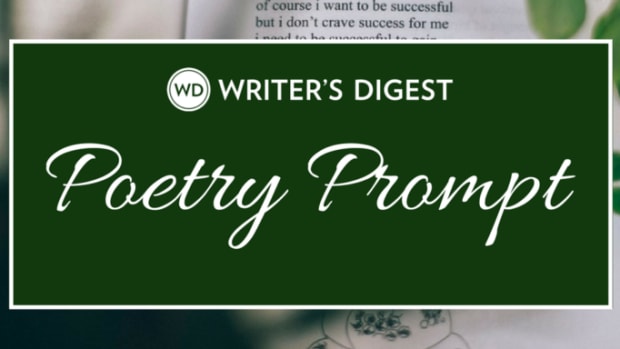
Wednesday Poetry Prompts: 698
Every Wednesday, Robert Lee Brewer shares a prompt and an example poem to get things started for poets. This week, write a vehicle poem.
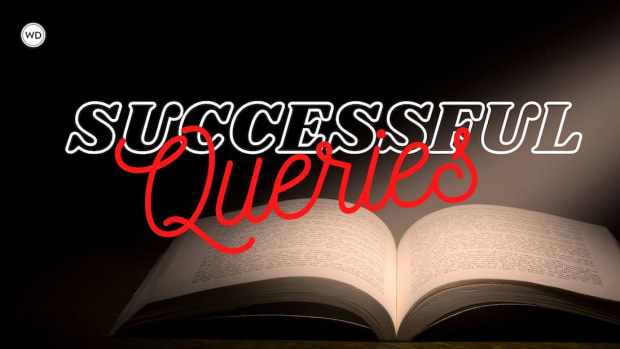
Successful Queries: Molly Ker Hawn and "Now, Conjurers," by Freddie Kölsch
The best way to learn how to write a successful query is to read one. In this installment, find a query letter accepted by Literary Agent Molly Ker Hawn for Freddie Kölsch's book, Now, Conjurers (Union Square & Co.).

Putting Truth to the Page in Memoir Writing
Author and "Hideologist" Karen Solt shares six thoughts on putting your personal truth to the page in writing, even (and maybe especially) when that truth is very difficult to share with the world.

The Ultimate Rom-Com Book Club Guide
Bestselling author Adriana Mather has put together the ultimate rom-com book club guide, including how to start one, possible activities, discussion questions, and more.

Mystery at the Community Cookout
Every writer needs a little inspiration once in a while. For today's prompt, write about someone trying to solve a mystery at a community cookout.

Desmond Hall: Find a Writing Community
In this interview, author Desmond Hall discusses the inspiration behind his new young adult novel, Better Must Come.

A Guide to Descriptive Writing
by Melissa Donovan | Jan 7, 2021 | Creative Writing | 9 comments
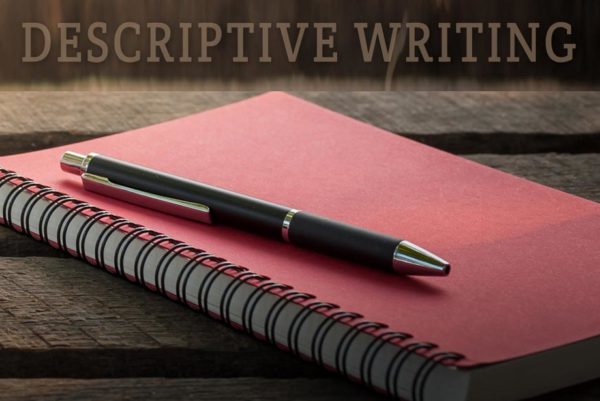
What is descriptive writing?
Writing description is a necessary skill for most writers. Whether we’re writing an essay, a story, or a poem, we usually reach a point where we need to describe something. In fiction, we describe settings and characters. In poetry, we describe scenes, experiences, and emotions. In creative nonfiction, we describe reality. Descriptive writing is especially important for speculative fiction writers and poets. If you’ve created a fantasy world, then you’ll need to deftly describe it to readers; Lewis Carroll not only described Wonderland (aff link); he also described the fantastical creatures that inhabited it.
But many writers are challenged by description writing, and many readers find it boring to read — when it’s not crafted skillfully.
However, I think it’s safe to say that technology has spoiled us. Thanks to photos and videos, we’ve become increasingly visual, which means it’s getting harder to use words to describe something, especially if it only exists in our imaginations.
What is Descriptive Writing?
One might say that descriptive writing is the art of painting a picture with words. But descriptive writing goes beyond visuals. Descriptive writing hits all the senses; we describe how things look, sound, smell, taste, and feel (their tactile quality).
The term descriptive writing can mean a few different things:
- The act of writing description ( I’m doing some descriptive writing ).
- A descriptive essay is short-form prose that is meant to describe something in detail; it can describe a person, place, event, object, or anything else.
- Description as part of a larger work: This is the most common kind of descriptive writing. It is usually a sentence or paragraph (sometimes multiple paragraphs) that provide description, usually to help the reader visualize what’s happening, where it’s happening, or how it’s happening. It’s most commonly used to describe a setting or a character. An example would be a section of text within a novel that establishes the setting by describing a room or a passage that introduces a character with a physical description.
- Writing that is descriptive (or vivid) — an author’s style: Some authors weave description throughout their prose and verse, interspersing it through the dialogue and action. It’s a style of writing that imparts description without using large blocks of text that are explicitly focused on description.
- Description is integral in poetry writing. Poetry emphasizes imagery, and imagery is rendered in writing via description, so descriptive writing is a crucial skill for most poets.
Depending on what you write, you’ve probably experimented with one of more of these types of descriptive writing, maybe all of them.
Can you think of any other types of descriptive writing that aren’t listed here?
How Much Description is Too Much?
Classic literature was dense with description whereas modern literature usually keeps description to a minimum.
Compare the elaborate descriptions in J.R.R. Tolkien’s Lord of the Rings trilogy with the descriptions in J.K. Rowling’s Harry Potter series (aff links). Both series relied on description to help readers visualize an imagined, fantastical world, but Rowling did not use her precious writing space to describe standard settings whereas Tolkien frequently paused all action and spent pages describing a single landscape.
This isn’t unique to Tolkien and Rowling; if you compare most literature from the beginning of of the 20th century and earlier to today’s written works, you’ll see that we just don’t dedicate much time and space to description anymore.
I think this radical change in how we approach description is directly tied to the wide availability of film, television, and photography. Let’s say you were living in the 19th century, writing a story about a tropical island for an audience of northern, urban readers. You would be fairly certain that most of your readers had never seen such an island and had no idea what it looked like. To give your audience a full sense of your story’s setting, you’d need pages of detail describing the lush jungle, sandy beaches, and warm waters.
Nowadays, we all know what a tropical island looks like, thanks to the wide availability of media. Even if you’ve never been to such an island, surely you’ve seen one on TV. This might explain why few books on the craft of writing address descriptive writing. The focus is usually on other elements, like language, character, plot, theme, and structure.
For contemporary writers, the trick is to make the description as precise and detailed as possible while keeping it to a minimum. Most readers want characters and action with just enough description so that they can imagine the story as it’s unfolding.
If you’ve ever encountered a story that paused to provide head-to-toe descriptions along with detailed backstories of every character upon their introduction into the narrative, you know just how grating description can be when executed poorly.
However, it’s worth noting that a skilled writer can roll out descriptions that are riveting to read. Sometimes they’re riveting because they’re integrated seamlessly with the action and dialogue; other times, the description is deftly crafted and engaging on its own. In fact, an expert descriptive writer can keep readers glued through multiple pages of description.
Descriptive Writing Tips
I’ve encountered descriptive writing so smooth and seamless that I easily visualized what was happening without even noticing that I was reading description. Some authors craft descriptions that are so lovely, I do notice — but in a good way. Some of them are so compelling that I pause to read them again.
On the other hand, poorly crafted descriptions can really impede a reader’s experience. Description doesn’t work if it’s unclear, verbose, or bland. Most readers prefer action and dialogue to lengthy descriptions, so while a paragraph here and there can certainly help readers better visualize what’s happening, pages and pages of description can increase the risk that they’ll set your work aside and never pick it up again. There are exceptions to every rule, so the real trick is to know when lengthy descriptions are warranted and when they’re just boring.
Here are some general tips for descriptive writing:
- Use distinct descriptions that stand out and are memorable. For example, don’t write that a character is five foot two with brown hair and blue eyes. Give the reader something to remember. Say the character is short with mousy hair and sky-blue eyes.
- Make description active: Consider the following description of a room: There was a bookshelf in the corner. A desk sat under the window. The walls were beige, and the floor was tiled. That’s boring. Try something like this: A massive oak desk sat below a large picture window and beside a shelf overflowing with books. Hardcovers, paperbacks, and binders were piled on the dingy tiled floor in messy stacks. In the second example, words like overflowing and piled are active.
- Weave description through the narrative: Sometimes a character enters a room and looks around, so the narrative needs to pause to describe what the character sees. Other times, description can be threaded through the narrative. For example, instead of pausing to describe a character, engage that character in dialogue with another character. Use the characters’ thoughts and the dialogue tags to reveal description: He stared at her flowing, auburn curls, which reminded him of his mother’s hair. “Where were you?” he asked, shifting his green eyes across the restaurant to where a customer was hassling one of the servers.
Simple descriptions are surprisingly easy to execute. All you have to do is look at something (or imagine it) and write what you see. But well-crafted descriptions require writers to pay diligence to word choice, to describe only those elements that are most important, and to use engaging language to paint a picture in the reader’s mind. Instead of spending several sentences describing a character’s height, weight, age, hair color, eye color, and clothing, a few, choice details will often render a more vivid image for the reader: Red hair framed her round, freckled face like a spray of flames. This only reveals three descriptive details: red hair, a round face, and freckles. Yet it paints more vivid picture than a statistical head-to-toe rundown: She was five foot three and no more than a hundred and ten pounds with red hair, blue eyes, and a round, freckled face.
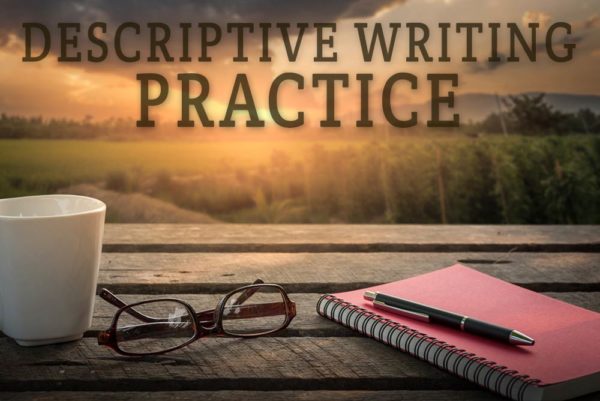
10 descriptive writing practices.
How to Practice Writing Description
Here are some descriptive writing activities that will inspire you while providing opportunities to practice writing description. If you don’t have much experience with descriptive writing, you may find that your first few attempts are flat and boring. If you can’t keep readers engaged, they’ll wander off. Work at crafting descriptions that are compelling and mesmerizing.
- Go to one of your favorite spots and write a description of the setting: it could be your bedroom, a favorite coffee shop, or a local park. Leave people, dialogue, and action out of it. Just focus on explaining what the space looks like.
- Who is your favorite character from the movies? Describe the character from head to toe. Show the reader not only what the character looks like, but also how the character acts. Do this without including action or dialogue. Remember: description only!
- Forty years ago we didn’t have cell phones or the internet. Now we have cell phones that can access the internet. Think of a device or gadget that we’ll have forty years from now and describe it.
- Since modern fiction is light on description, many young and new writers often fail to include details, even when the reader needs them. Go through one of your writing projects and make sure elements that readers may not be familiar with are adequately described.
- Sometimes in a narrative, a little description provides respite from all the action and dialogue. Make a list of things from a story you’re working on (gadgets, characters, settings, etc.), and for each one, write a short description of no more than a hundred words.
- As mentioned, Tolkien often spent pages describing a single landscape. Choose one of your favorite pieces of classic literature, find a long passage of description, and rewrite it. Try to cut the descriptive word count in half.
- When you read a book, use a highlighter to mark sentences and paragraphs that contain description. Don’t highlight every adjective and adverb. Look for longer passages that are dedicated to description.
- Write a description for a child. Choose something reasonably difficult, like the solar system. How do you describe it in such a way that a child understands how he or she fits into it?
- Most writers dream of someday writing a book. Describe your book cover.
- Write a one-page description of yourself.
If you have any descriptive writing practices to add to this list, feel free to share them in the comments.
Descriptive Writing
Does descriptive writing come easily to you, or do you struggle with it? Do you put much thought into how you write description? What types of descriptive writing have you tackled — descriptive essays, blocks of description within larger texts, or descriptions woven throughout a narrative? Share your tips for descriptive writing by leaving a comment, and keep writing!
Further Reading: Abolish the Adverbs , Making the Right Word Choices for Better Writing , and Writing Description in Fiction .

I find descriptions easier when first beginning a scene. Other ones I struggle with. Yes, intertwining them with dialogue does help a lot.
I have the opposite experience. I tend to dive right into action and dialogue when I first start a scene.
I came across this article at just the right time. I am just starting to write a short story. This will change the way I describe characters in my story.
Thank you for this. R.G. Ramsey
You’re welcome!
Great tips and how to practise and improve our descriptive writing skills. Thank you for sharing.
You’re welcome, Bella.
Hello Melissa
I have read many of your articles about different aspects of writing and have enjoyed all of them. What you said here, I agree with, with the exception of #7. That is one point that I dispute and don’t understand the reason why anyone would do this, though I’ve seen books that had things like that done to them.
To me, a book is something to be treasured, loved and taken care of. It deserves my respect because I’m sure the author poured their heart and soul into its creation. Marking it up that way is nothing short of defacing it. A book or story is a form of art, so should a person mark over a picture by Rembrandt or any other famous painter? You’re a very talented author, so why would you want someone to mark through the words you had spent considerable time and effort agonizing over, while searching for the best words to convey your thoughts?
If I want to remember some section or point the author is making, then I’ll take a pen and paper and record the page number and perhaps the first few words of that particular section. I’ve found that writing a note this way helps me remember it better. This is then placed inside the cover for future reference. If someone did what you’ve suggested to a book of mine, I’d be madder than a ‘wet hen’, and that person would certainly be told what I thought of them.
In any of the previous articles you’ve written, you’ve brought up some excellent points which I’ve tried to incorporate in my writing. Keep up the good work as I know your efforts have helped me, and I’m sure other authors as well.
Hi Stanley. Thanks so much for sharing your point of view. I appreciate and value it.
Marking up a book is a common practice, especially in academia. Putting notes in margins, underlining, highlighting, and tagging pages with bookmarks is standard. Personally, I mark up nonfiction paperbacks, but I never mark up fiction paperbacks or any hardcovers (not since college).
I completely respect your right to keep your books in pristine condition. And years ago, when I started college, I felt exactly the same way. I was horrified that people (instructors and professors!) would fill their books with ugly yellow highlighting and other markips. But I quickly realized that this was shortsighted.
Consider an old paperback that is worn and dog-eared. With one look, you know this book has been read many times and it’s probably loved. It’s like the Velveteen Rabbit of books. I see markups as the same — that someone was engaging with the book and trying to understand it on a deeper level, which is not disrespectful. It’s something to be celebrated.
Sometimes we place too much value on the book as a physical object rather than what’s inside. I appreciate a beautiful book as much as anyone but what really matters to me is the information or experience that it contains. I often read on a Kindle. Sometimes I listen to audio books. There is no physical book. The experience is not lessened.
I understand where you’re coming from. I used to feel the same way, but my mind was changed. I’m not trying to change yours, but I hope you’ll understand.
You’ve provided some great information and advice. One thing I might add–it is helpful to consider the POV character. For example, what will they notice in a restaurant? A police officer may notice the placement of the exits, the tattooed man carrying a side-arm, the security cameras on the ceiling, etc. The descriptive items he would notice would be very different from those of an elderly grandmother or a fifteen-year-old teenaged girl.
Trackbacks/Pingbacks
- 7 Sites You’ve Got to Check Out About Journaling! | The NoteBook Blogairy - […] Writing Forward: This eight-year-old website has TONS of great writerly information to share including a really wonderful piece about…
Submit a Comment Cancel reply
Your email address will not be published. Required fields are marked *
This site uses Akismet to reduce spam. Learn how your comment data is processed .

Subscribe and get The Writer’s Creed graphic e-booklet, plus a weekly digest with the latest articles on writing, as well as special offers and exclusive content.

Recent Posts
- Consuming Art to Fuel Your Writing
- How to Improve Your Writing
- Writing Tips: Be Yourself
- A Must-Read for Storytellers: Save the Cat
- Poetry Prompts for Language Lovers
Write on, shine on!
Pin It on Pinterest
History’s Most Over-the-Top Sunset Descriptions
Long before instagram, sunset enthusiasts strained the english language to its limit..

“Sunset Over the Golden Horn,” by Ivan Constantinovich Aivazovsky, from 1866. (Image: Public Domain )
Sunsets: they’re great. Nowadays, we can show off our sunset-spotting prowess across a variety of media. You can Tweet a sunset. You can Snap a sunset, then ‘gram it for good measure. You can Youtube or Vine a variety of sunsets over the course of a particular timespan. The possibilities are as large as the sun itself.
But before color photography was invented in 1866, those who wanted to get across their latest and/or greatest sunset experience had only two available modes: painting, and extremely purple prose. Many, many people rose to the challenge: Newspapers, memoirs, travelogues, and scientific treatises are all full of charmingly lurid paeans to the colorful end of the day, tinted further by a variety of forces.
Criteria for this collection was scrupulous: no fictional or metaphorical sunsets (otherwise, you open yourself up to poetry—a terrible wormhole); no sunrises (too sanctimonious); pre-1866 only. Here are the most vivid sunsets we found.
1. “The Suns true place…”
“By which Tables on Saturday April 9th, at the time of Sun-set, supposed at 7 ho. 3 minutes P.M. I find:

John Flamstead, Philosophical Transactions , 1669

A British sunset, feat. much mellowness of light. (Photo: Keith Laverack/CC BY-SA 2.0 )
2. “Such rich and varied dyes”
“Where, after all, shall we find Sunsets equal to British ones? Where such serenely beautiful horizons—such rich and varied dyes–such mellowness of light—such objects to be irradiated by it—and evenings so happily adapted for contemplating them? The mixture of fierceness and gloom in a West India Sunset, call the mind the coarseness of the people there, and the implacable deadliness of the climate; the milder glories of one in the Southern Atlantic, can be enjoyed at sea only, where everything else is unpleasing; the effect of a similar scene in America is injured by want of objects of antiquity, and of the lofty associations connected with them; and in India, the tropical glare attending the departure of day, forces us to imprison ourselves while it is taking place, and to remember that we are in exile.”
John Howison, “Sunset in Different Climes,” Times Telescope , 1826
3. “A smaller minute sprinkle”
“There was a fine sunset over the hills of Granada. I imagined it lighting up the Alhambra. The clouds were like great wings of gold and yellow and rose-colour, with a smaller minute sprinkle in one spot, like a shower of glowing stones from a volcano. You see very faint imitations of such lustre in England.”
Leigh Hunt, Visit to Italy , 1828

Sunset in Portugal, glorious to behold. (Photo: Alvegaspar/Gnu 1.2 )
4. “Increasing every moment”
“The mists were rolling away from his feet in huge wreaths, which gradually, as they became thinner, received and transmitted the rays of an evening sun, and were lighted up with a golden and crimson radiance, glorious to behold, and increasing every moment in splendor.”
“Book Review: ‘Calavar,’” The North American Review , 1835.
5. “The brilliancy of the colors”
“To a native of New England, few objects appear more beautiful than the setting of the sun as it appears from the hills and valleys of her mountains. The clearness of the atmosphere, and the brilliancy of the colors, fasten his gaze upon the west as the sun has just sunk behind the mountains. As he passes, however, to the middle and western parts of the State of New York, the sunsets become still more beautiful, and often absolutely splendid.”
Prof. C. Dewey, American Journal of Science , 1840.
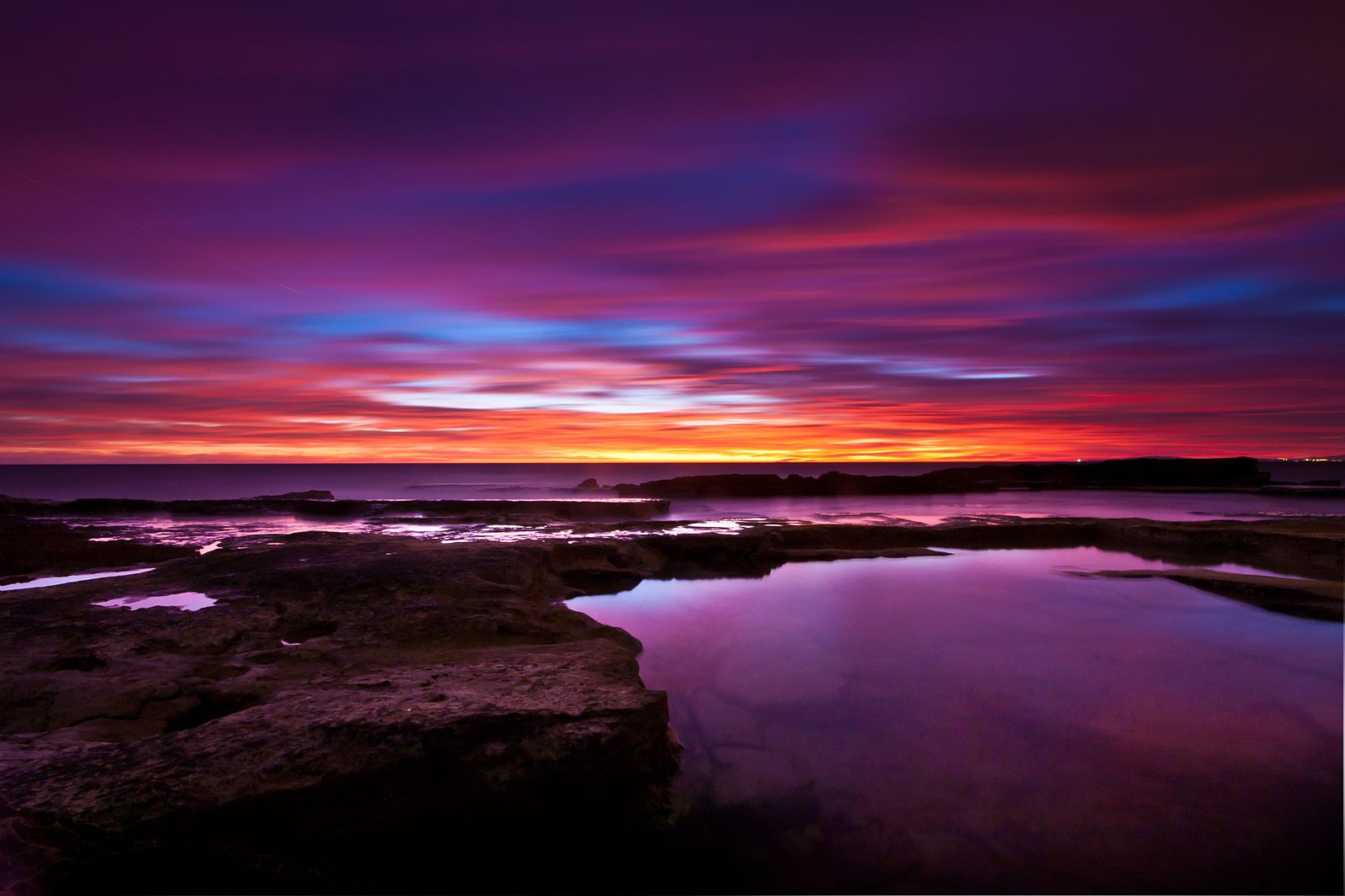
What can the citizen know of sights like this Mallorca sunset? (Photo: Andrés Nieto Porras/CC BY-SA 2.0 )
6. “The azure of a thousand miles of champaign”
“What can the citizen, who can see only the red light on the canvass of the waggon at the end of the street, and the crimson colour of the bricks of his neighbor’s chimney, know of the flood of fire which deluges the sky from the horizon to the zenith? What can even the quiet inhabitant of the English lowlands, whose scene for the manifestation of the fire of heaven is limited to the tops of hayricks, and the rooks’ nests in the old elm-trees, know of the mighty passages of splendour which are tossed from Alp to Alp over the azure of a thousand miles of champaign?… What recollection have we of the sunsets which delighted us last year?”
John Ruskin, Modern Painters , 1843.
7. “The changeful rose color”
“The island seemed to fold in, as it were, with the westerly cliffs of the Cape, until in a south view they formed one towering, stupendous mass of dark rocks, most richly tinged with the changeful rose color, and purple, and gold of the sunset’s glorious hues, which shone forth in still greater lustre from contrast with the deep chasms and ravines which were in almost black shadow, and with the white crested hills of the blue sea, that dashed their glittering spray high over the broken crags. It was a scene never to be forgotten.”
Louisa Anne Meredith, My Home in Tasmania , 1853.
8. “A tedious, stupid sun”
“If ever there was a tedious sunset it was the one that took place on this night. Sunsets had been generally rather a fertile source of conversation at Mr. Tulip’s. It was usual to go out on the piazza and watch them, and expatiate upon their beauty—though, if I may be allowed to whisper the heresy, I never in my life saw sunsets that were all so like one another as those at Tulipton—and the ladies grew sentimental watching them, and the gentlemen poetical, and much enthusiastic exclamation attended the retirement of the drowsy luminary. But on this memorable occasion every one grew disgusted with him. There never was such a tedious, stupid sun.”
F.J. O’Brien, New York Times , 1853.
9. “Athwart his majestic easel”
“As the sun goes down he begins to fling his parting rays across all the sky, from horizon to zenith. He paints the clouds with his fiery pigments, and they glow with gorgeous colors from lake to river. Golden and yellow near the track of his disappearance, the hues change to boundless masses of pink, and crimson, and scarlet, and purple, further up the dome of the sky… Fiery as are the colors this sun-painter flings athwart his majestic easel, yet are they by so much the more quickly burned out and faded. The sunset is gorgeous only to be perishable and transitory. Gold changes to crimson, crimson deepens to purple, and soon the glory of the heavens is passed away. We turn and journey silently down to the lake.”
“Letter from Lake Oscawana,” New York Times , October 13th, 1865.
Found: A Magnificent Roman Villa, Hiding Under a British Backyard

Using an ad blocker?
We depend on ad revenue to craft and curate stories about the world’s hidden wonders. Consider supporting our work by becoming a member for as little as $5 a month.
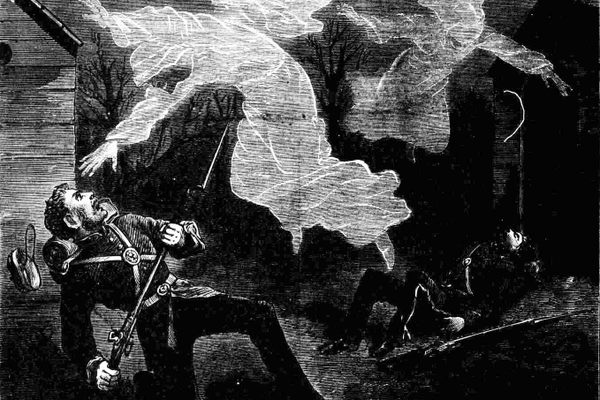
The Mischievous 'Ghost Hoaxers' of 19th-Century Australia
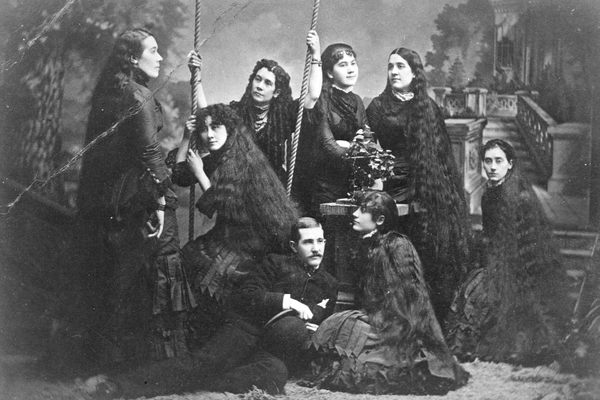
How 7 Sisters Made a Fortune off Their Rapunzel-Like Hair

And Now, a Weather Report From Mars

The Once-Common Practice of Communal Sleeping

Venezuela's Everlasting Lightning Storm

Follow us on Twitter to get the latest on the world's hidden wonders.
Like us on Facebook to get the latest on the world's hidden wonders.
The Atlas Obscura Podcast is Back!

Add Some Wonder to Your Inbox
We'd like you to like us.

Virtual Tour
Experience University of Idaho with a virtual tour. Explore now
- Discover a Career
- Find a Major
- Experience U of I Life
More Resources
- Admitted Students
- International Students
Take Action
- Find Financial Aid
- View Deadlines
- Find Your Rep

Helping to ensure U of I is a safe and engaging place for students to learn and be successful. Read about Title IX.
Get Involved
- Clubs & Volunteer Opportunities
- Recreation and Wellbeing
- Student Government
- Student Sustainability Cooperative
- Academic Assistance
- Safety & Security
- Career Services
- Health & Wellness Services
- Register for Classes
- Dates & Deadlines
- Financial Aid
- Sustainable Solutions
- U of I Library

- Upcoming Events
Review the events calendar.
Stay Connected
- Vandal Family Newsletter
- Here We Have Idaho Magazine
- Living on Campus
- Campus Safety
- About Moscow

The largest Vandal Family reunion of the year. Check dates.
Benefits and Services
- Vandal Voyagers Program
- Vandal License Plate
- Submit Class Notes
- Make a Gift
- View Events
- Alumni Chapters
- University Magazine
- Alumni Newsletter

U of I's web-based retention and advising tool provides an efficient way to guide and support students on their road to graduation. Login to VandalStar.
Common Tools
- Administrative Procedures Manual (APM)
- Class Schedule
- OIT Tech Support
- Academic Dates & Deadlines
- U of I Retirees Association
- Faculty Senate
- Staff Council
Department of English
M.f.a. creative writing.
English Department
Physical Address: 200 Brink Hall
Mailing Address: English Department University of Idaho 875 Perimeter Drive MS 1102 Moscow, Idaho 83844-1102
Phone: 208-885-6156
Email: [email protected]
Web: English
Thank you for your interest in the Creative Writing MFA Program at the University of Idaho: the premier fully funded, three-year MFA program in the Northwest. Situated in the panhandle of Northern Idaho in the foothills of Moscow Mountain, we offer the time and support to train in the traditions, techniques, and practice of nonfiction, poetry, and fiction. Each student graduates as the author of a manuscript of publishable quality after undertaking a rigorous process of thesis preparation and a public defense. Spring in Moscow has come to mean cherry blossoms, snowmelt in Paradise Creek, and the head-turning accomplishments of our thesis-year students. Ours is a faculty of active, working writers who relish teaching and mentorship. We invite you in the following pages to learn about us, our curriculum, our community, and the town of Moscow. If the prospect of giving yourself three years with us to develop as a writer, teacher, and editor is appealing, we look forward to reading your application.
Pure Poetry
A Decade Working in a Smelter Is Topic of Alumnus Zach Eddy’s Poems
Ancestral Recognition
The region surrounding the University of Idaho is the ancestral land of both the Coeur d’Alene and Nez Perce peoples, and its campus in Moscow sits on unceded lands guaranteed to the Nez Perce people in the 1855 Treaty with the Nez Perce. As a land grant university, the University of Idaho also benefits from endowment lands that are the ancestral homes to many of the West’s Native peoples. The Department of English and Creative Writing Program acknowledge this history and share in the communal effort to ensure that the complexities and atrocities of the past remain in our discourse and are never lost to time. We invite you to think of the traditional “land acknowledgment” statement through our MFA alum CMarie Fuhrman’s words .
Degree Requirements
Three years to write.
Regardless of where you are in your artistic career, there is nothing more precious than time. A three-year program gives you time to generate, refine, and edit a body of original work. Typically, students have a light third year, which allows for dedicated time to complete and revise the Creative Thesis. (48 manuscript pages for those working in poetry, 100 pages for those working in prose.)
Our degree requirements are designed to reflect the real-world interests of a writer. Students are encouraged to focus their studies in ways that best reflect their artistic obsessions as well as their lines of intellectual and critical inquiry. In effect, students may be as genre-focused or as multi-genre as they please. Students must remain in-residence during their degrees. Typically, one class earns you 3 credits. The MFA requires a total of 54 earned credits in the following categories.
12 Credits : Graduate-level Workshop courses in Fiction, Poetry, and/or Nonfiction. 9 Credits: Techniques and Traditions courses in Fiction, Poetry, and/or Nonfiction 3 Credits : Internships: Fugue, Confluence Lab, and/or Pedagogy 9 Credits: Literature courses 12 Credits: Elective courses 10 Credits: Thesis
Flexible Degree Path
Students are admitted to our program in one of three genres, Poetry, Fiction, or Nonfiction. By design, our degree path offers ample opportunity to take Workshop, Techniques, Traditions, and Literature courses in any genre. Our faculty work and publish in multiple genres and value the slipperiness of categorization. We encourage students to write in as broad or focused a manner as they see fit. We are not at all interested in making writers “stay in their lanes,” and we encourage students to shape their degree paths in accordance with their passions.
What You Study
During your degree, you will take Workshop, Techniques, Traditions, and Literature courses.
Our workshop classes are small by design (typically twelve students or fewer) and taught by core and visiting MFA faculty. No two workshop experiences look alike, but what they share are faculty members committed to the artistic and intellectual passions of their workshop participants.
Techniques studios are developed and taught by core and visiting MFA faculty. These popular courses are dedicated to the granular aspects of writing, from deep study of the poetic image to the cultivation of independent inquiry in nonfiction to the raptures of research in fiction. Such courses are heavy on generative writing and experimentation, offering students a dedicated space to hone their craft in a way that is complementary to their primary work.
Traditions seminars are developed and taught by core and visiting MFA faculty. These generative writing courses bring student writing into conversation with a specific trajectory or “tradition” of literature, from life writing to outlaw literature to the history of the short story, from prosody to postwar surrealism to genre-fluidity and beyond. These seminars offer students a dynamic space to position their work within the vast and varied trajectories of literature.
Literature courses are taught by core Literature and MFA faculty. Our department boasts field-leading scholars, interdisciplinary writers and thinkers, and theory-driven practitioners who value the intersection of scholarly study, research, humanism, and creative writing.
Award-Winning Faculty
We teach our classes first and foremost as practitioners of the art. Full stop. Though our styles and interests lie at divergent points on the literary landscape, our common pursuit is to foster the artistic and intellectual growth of our students, regardless of how or why they write. We value individual talent and challenge all students to write deep into their unique passions, identities, histories, aesthetics, and intellects. We view writing not as a marketplace endeavor but as an act of human subjectivity. We’ve authored or edited several books across the genres.
Learn more about Our People .
Thesis Defense
The MFA experience culminates with each student writing and defending a creative thesis. For prose writers, theses are 100 pages of creative work; for poets, 48 pages. Though theses often take the form of an excerpt from a book-in-progress, students have flexibility when it comes to determining the shape, form, and content of their creative projects. In their final year, each student works on envisioning and revising their thesis with three committee members, a Major Professor (core MFA faculty) and two additional Readers (core UI faculty). All students offer a public thesis defense. These events are attended by MFA students, faculty, community members, and other invitees. During a thesis defense, a candidate reads from their work for thirty minutes, answers artistic and critical questions from their Major Professor and two Readers for forty-five minutes, and then answer audience questions for thirty minutes. Though formally structured and rigorous, the thesis defense is ultimately a celebration of each student’s individual talent.
The Symposium Reading Series is a longstanding student-run initiative that offers every second-year MFA candidate an opportunity to read their works-in-progress in front of peers, colleagues, and community members. This reading and Q & A event prepares students for the third-year public thesis defense. These off-campus events are fun and casual, exemplifying our community centered culture and what matters most: the work we’re all here to do.
Teaching Assistantships
All students admitted to the MFA program are fully funded through Teaching Assistantships. All Assistantships come with a full tuition waiver and a stipend, which for the current academic year is roughly $15,000. Over the course of three years, MFA students teach a mix of composition courses, sections of Introduction to Creative Writing (ENGL 290), and additional writing courses, as departmental needs arise. Students may also apply to work in the Writing Center as positions become available. When you join the MFA program at Idaho, you receive teacher training prior to the beginning of your first semester. We value the role MFA students serve within the department and consider each graduate student as a working artist and colleague. Current teaching loads for Teaching Assistants are two courses per semester. Some members of the Fugue editorial staff receive course reductions to offset the demands of editorial work. We also award a variety of competitive and need-based scholarships to help offset general living costs. In addition, we offer three outstanding graduate student fellowships: The Hemingway Fellowship, Centrum Fellowship, and Writing in the Wild Fellowship. Finally, our Graduate and Professional Student Association offers extra-departmental funding in the form of research and travel grants to qualifying students throughout the academic year.
Distinguished Visiting Writers Series
Each year, we bring a Distinguished Visiting Writer to campus. DVWs interface with our writing community through public readings, on-stage craft conversations hosted by core MFA faculty, and small seminars geared toward MFA candidates. Recent DVWs include Maggie Nelson, Roger Reeves, Luis Alberto Urrea, Brian Evenson, Kate Zambreno, Dorianne Laux, Teju Cole, Tyehimba Jess, Claire Vaye Watkins, Naomi Shihab Nye, David Shields, Rebecca Solnit, Gabrielle Calvocoressi, Susan Orlean, Natasha Tretheway, Jo Ann Beard, William Logan, Aisha Sabatini Sloan, Gabino Iglesias, and Marcus Jackson, among several others.
Fugue Journal
Established in 1990 at the University of Idaho, Fugue publishes poetry, fiction, essays, hybrid work, and visual art from established and emerging writers and artists. Fugue is managed and edited entirely by University of Idaho graduate students, with help from graduate and undergraduate readers. We take pride in the work we print, the writers we publish, and the presentation of both print and digital content. We hold an annual contest in both prose and poetry, judged by two nationally recognized writers. Past judges include Pam Houston, Dorianne Laux, Rodney Jones, Mark Doty, Rick Moody, Ellen Bryant Voigt, Jo Ann Beard, Rebecca McClanahan, Patricia Hampl, Traci Brimhall, Edan Lepucki, Tony Hoagland, Chen Chen, Aisha Sabatini Sloan, sam sax, and Leni Zumas. The journal boasts a remarkable list of past contributors, including Steve Almond, Charles Baxter, Stephen Dobyns, Denise Duhamel, Stephen Dunn, B.H. Fairchild, Nick Flynn, Terrance Hayes, Campbell McGrath, W.S. Merwin, Sharon Olds, Jim Shepard, RT Smith, Virgil Suarez, Melanie Rae Thon, Natasha Trethewey, Philip Levine, Anthony Varallo, Robert Wrigley, and Dean Young, among many others.
Academy of American Poets University Prize
The Creative Writing Program is proud to partner with the Academy of American Poets to offer an annual Academy of American Poets University Prize to a student at the University of Idaho. The prize results in a small honorarium through the Academy as well as publication of the winning poem on the Academy website. The Prize was established in 2009 with a generous grant from Karen Trujillo and Don Burnett. Many of our nation’s most esteemed and celebrated poets won their first recognition through an Academy of American Poets Prize, including Diane Ackerman, Toi Derricotte, Mark Doty, Tess Gallagher, Louise Glück, Jorie Graham, Kimiko Hahn, Joy Harjo, Robert Hass, Li-Young Lee, Gregory Orr, Sylvia Plath, Mark Strand, and Charles Wright.
Fellowships
Centrum fellowships.
Those selected as Centrum Fellows attend the summer Port Townsend Writers’ Conference free of charge. Housed in Fort Worden (which is also home to Copper Canyon Press), Centrum is a nonprofit dedicated to fostering several artistic programs throughout the year. With a focus on rigorous attention to craft, the Writers’ Conference offers five full days of morning intensives, afternoon workshops, and craft lectures to eighty participants from across the nation. The cost of the conference, which includes tuition, lodging, and meals, is covered by the scholarship. These annual scholarship are open to all MFA candidates in all genres.
Hemingway Fellowships
This fellowship offers an MFA Fiction student full course releases in their final year. The selection of the Hemingway Fellow is based solely on the quality of an applicant’s writing. Each year, applicants have their work judged blind by a noted author who remains anonymous until the selection process has been completed. Through the process of blind selection, the Hemingway Fellowship Fund fulfills its mission of giving the Fellow the time they need to complete a substantial draft of a manuscript.
Writing in the Wild
This annual fellowship gives two MFA students the opportunity to work in Idaho’s iconic wilderness areas. The fellowship fully supports one week at either the McCall Outdoor Science School (MOSS), which borders Payette Lake and Ponderosa State Park, or the Taylor Wilderness Research Station, which lies in the heart of the Frank Church River of No Return Wilderness Area. Both campuses offer year-round housing. These writing retreats allow students to concentrate solely on their writing. Because both locations often house researchers, writers will also have the opportunity to interface with foresters, geologists, biologists, and interdisciplinary scholars.
Program History
Idaho admitted its first class of seven MFA students in 1994 with a faculty of four: Mary Clearman Blew, Tina Foriyes, Ron McFarland (founder of Fugue), and Lance Olsen. From the beginning, the program was conceived as a three-year sequence of workshops and techniques classes. Along with offering concentrations in writing fiction and poetry, Idaho was one of the first in the nation to offer a full concentration in creative nonfiction. Also from its inception, Idaho not only allowed but encouraged its students to enroll in workshops outside their primary genres. Idaho has become one of the nation’s most respected three-year MFA programs, attracting both field-leading faculty and students. In addition to the founders of this program, notable distinguished faculty have included Kim Barnes, Robert Wrigley, Daniel Orozco, Joy Passanante, Tobias Wray, Brian Blanchfield, and Scott Slovic, whose collective vision, rigor, grit, and care have paved the way for future generations committed to the art of writing.
The Palouse
Situated in the foothills of Moscow Mountain amid the rolling terrain of the Palouse (the ancient silt beds unique to the region), our location in the vibrant community of Moscow, Idaho, boasts a lively and artistic local culture. Complete with independent bookstores, coffee shops, art galleries, restaurants and breweries, (not to mention a historic art house cinema, organic foods co-op, and renowned seasonal farmer’s market), Moscow is a friendly and affordable place to live. Outside of town, we’re lucky to have many opportunities for hiking, skiing, rafting, biking, camping, and general exploring—from nearby Idler’s Rest and Kamiak Butte to renowned destinations like Glacier National Park, the Snake River, the Frank Church River of No Return Wilderness Area, and Nelson, BC. As for more urban getaways, Spokane, Washington, is only a ninety-minute drive, and our regional airline, Alaska, makes daily flights to and from Seattle that run just under an hour.
For upcoming events and program news, please visit our calendar .
For more information about the MFA program, please contact us at: [email protected]
Department of English University of Idaho 875 Perimeter Drive MS 1102 Moscow, ID 83844-1102 208-885-6156
Quotes and Descriptions to Inspire Creative Writing Discover, Share, Connect
Search for creative inspiration
19,898 quotes, descriptions and writing prompts, 4,964 themes

marvellous school of neurology
"It turns out, as obviousness would have it, that our brains (especially those of Stan Lee and Jack Kirby in this case) have been teaching us neurology through comic books and the movies that have come from them." Full article linked to from my profile, click "abraham" below, awesome!!
There was a happiness to her, not the kind that is loud and obvious, but more as early morning birdsong.

essential career advice for writers
"For writers in the next half century and beyond, a comprehension of how creative writing, neurology, biology and our environment interact will be essential for a successful career." - a link to the full article is in my bio and on the Descriptionari "About" page. Much love!!! Angela Abraham (Daisy)
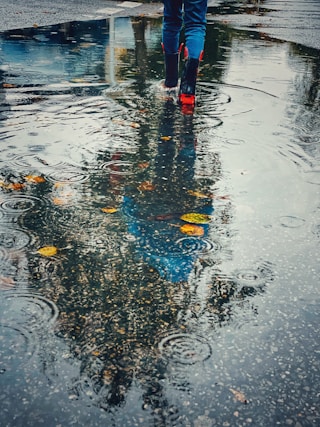
walking in the rain
I won't say I love the cold rain. I won't say I love being soaked to the skin. I won't say I'm alright with how long it takes for my boots to dry. But I will say it enlivens me and awakens a part of me that slumbers in the warm and sunny weather. I will say that jumping in puddles is fun and that I'm far too old to be enjoying such things. I will say that a part of me finds a beauty in wondering how many raindrops there are and listening for them in the meditative pitter patter.

I wonder if the roof tiles miss the rain on these long summer days. I wonder if they miss making their together song. Or perhaps they await the tickle of bird feet and a hearth-warm breeze. Or maybe it is the variation that makes these seasons special.

blanket fort
In that artistry of wool, within a fabric that told of patient hours of tip-tapping knitting needles, we dwelled within a castle within our home.

It was a bonny path that chattered day and night, the free leaves upon it and their twig-attached brethren in seasonal conversation.
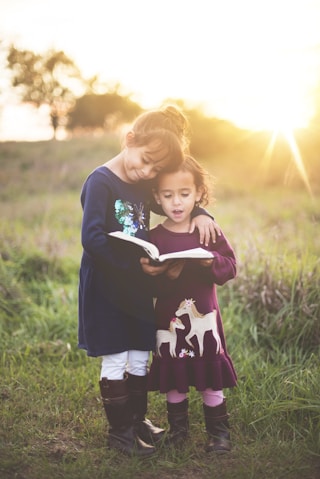
"When we make daily choices that are emotionally indifferent, the sort that the money-nexus makes faux-virtues of, we build our capacity for emotional indifference at the direct expense of our capacity for empathy, and thus the conflict between money and love is laid bare."
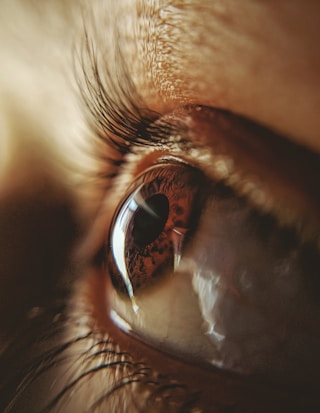
My soul, you see, is a pretty poem on paper scrunched and charred. In time, with care, she will unfold again and the words will be as beautiful as they ever were.
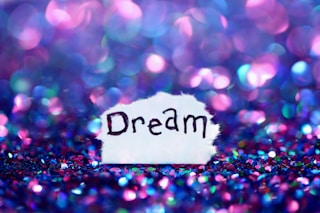
"Adjective and noun associations are worthy of our consideration because by careful linkage of words such as 'black' with strong emotionally positive words (such as in 'black heavens' and 'noble black night') we can start to program subconscious bias from the brain by creating a background neurochemistry that is more positive. This keeps the prefrontal cortex more fully operational and encourages more empathy in both thoughts and behaviours. Thus society develops better through their own choices and evolves. This is part of social evolution and this kind of awareness in writers is essential."
Sign in or sign up for Descriptionar i
Sign up for descriptionar i, recover your descriptionar i password.
Keep track of your favorite writers on Descriptionari
We won't spam your account. Set your permissions during sign up or at any time afterward.

IMAGES
VIDEO
COMMENTS
By Angela Abraham, @daisydescriptionari, April 4, 2020 . Dusk comes to bring us moonlight, to the time of reflection upon the day passed and awaiting day to be renewed by the light of the sun. It is when the birds sing goodnight until the stars bid them to dream under-wing. Each hue deepens in noble solemnity, finding unity in the night.
Luminous - To express the radiant light emitted by the setting sun. Crimson - To depict the deep, rich red color in the sunset sky. Glowing - Ideal for the warm radiance that engulfs the sky. Hazy - Useful for slight obscurity or softness to the sunset. Dusky - Describes the darker phase of sunset or twilight.
1. The sun dipped below the horizon, painting the sky in hues of pink and gold. 2. As daylight faded, the horizon became a canvas of fiery oranges and purples. 3. A warm glow enveloped the landscape as the sun bid farewell to the day. 4. The tranquil evening sky was adorned with the soft pastels of a setting sun. 5.
This section will explore two key aspects of sunset writing: color descriptions and the use of adjectives and metaphors. Color Descriptions. One of the most important elements of a sunset is its color. The sky can take on a range of hues, from soft pinks and oranges to fiery reds and purples. Writers can use a variety of color descriptions to ...
How it Adds Description "Splendid" is an excellent adjective to describe a pleasant sunset. This could imply that the sunset colors are very bright, but it could also show that the atmosphere to watch the sunset in is also very nice. Characters will likely feel very relaxed when watching a splendid sunset, which might even bring them joy. 2 ...
Amber - This is the color you might expect to see during dusk or early in the morning. Copper - We'll often use "copper" as an adjective in creative descriptions, ... Sun metaphors can help enhance your writing and make it more descriptive. Aim to create an image in your reader's mind by using adjectives and colors that match the ...
Mastering sunset descriptions can enhance your writing, connecting you and your readers to the beauty of nature. ... As the sun sinks closer to the horizon, its glow starts to diminish, making way for the deep purples and blues of dusk. The last rays of sunlight cast a luminous effect upon the clouds, turning them into a canvas for the final ...
Home » Rhyme & Rhythm. Describing a sunset in an essay, poem, book or short story requires descriptive adjectives and the use of literary devices, such as imagery, metaphors and symbolism. Sunsets represent warmth and beauty, often signifying an important season in a character's life, so descriptions tend to have a peaceful, melancholy tone.
Example 1: Dusk stained the glistening foliage with shadow and murk. As nightfall descended, the sounds of the jungle began to ebb. Uncertainty hung in the warm, wet air as the creatures began to prepare for the long stretch of darkness. ... Excellent piece of writing, I especially liked how descriptive you had made the little bits and phrases ...
It is advice on how to break free of cliche approaches to painting, but it applies almost just as well to writing. The first step to vividly describing a place, person, or thing is to imagine it in your mind's eye. Alternately, if it actually exists you may prefer to look at it or a photograph directly. Either way, you'll start with some ...
Describe dusk : search results on Descriptionari Descriptionari is a place where students, educators and professional writers discover and share inspirational writing and amazing descriptions Descriptionar i
Setting is much more than just a backdrop, which is why choosing the right one and describing it well is so important. To help with this, we have expanded and integrated this thesaurus into our online library at One Stop For Writers.Each entry has been enhanced to include possible sources of conflict, people commonly found in these locales, and setting-specific notes and tips, and the ...
Adding an object as beautiful as a sunset into a quote makes it lovelier. There are diverse, inspiring, mood-lifting, and soul-touching sunset quotes out there that you can use. Here's a list of beautiful sunset quotes you can use. "Every sunset gives hope that the day would start and end beautifully.". - Unknown.
Say your sentences aloud, and consider the overall tone of your writing. Practice choosing the perfect words for your descriptions—the words that will leave a lasting impression with your readers. Excerpted from the Creativity & Expression Writers Online Workshop. WD Online Course:
Writing description is a necessary skill for most writers. Whether we're writing an essay, a story, or a poem, we usually reach a point where we need to describe something. In fiction, we describe settings and characters. In poetry, we describe scenes, experiences, and emotions. In creative nonfiction, we describe reality.
Here are the most vivid sunsets we found. 1. "The Suns true place…". "By which Tables on Saturday April 9th, at the time of Sun-set, supposed at 7 ho. 3 minutes P.M. I find: John Flamstead ...
For more information about the MFA program, please contact us at: [email protected]. Department of English. University of Idaho. 875 Perimeter Drive MS 1102. Moscow, ID 83844-1102. 208-885-6156. The Master of Fine Arts Creative Writing program at the University of Idaho is an intense, three-year course of study that focuses on the ...
This Creative Writing program at University of Idaho could be a good fit if you: Are an aspiring professional writer; Want to teach creative writing at university or college level; Have a strong background in creative writing; Self-motivated and goal-oriented; Eager to be challenged, technically and creatively; Committed to developing your craft
The institute was founded in 1933 on the initiative of Maxim Gorky, a writer, founder of the socialist realism literary method, and a political activist. [2] It received its current name at Gorky's death in 1936. The institute has been at the same location, not far from Pushkin Square, for more than seventy years, in a complex of historic ...
love nexus. "When we make daily choices that are emotionally indifferent, the sort that the money-nexus makes faux-virtues of, we build our capacity for emotional indifference at the direct expense of our capacity for empathy, and thus the conflict between money and love is laid bare." Creative writing ideas by abraham.